Epson ACULASER C3800, ACULASER C3800N, ACULASER C3800DTN Manual
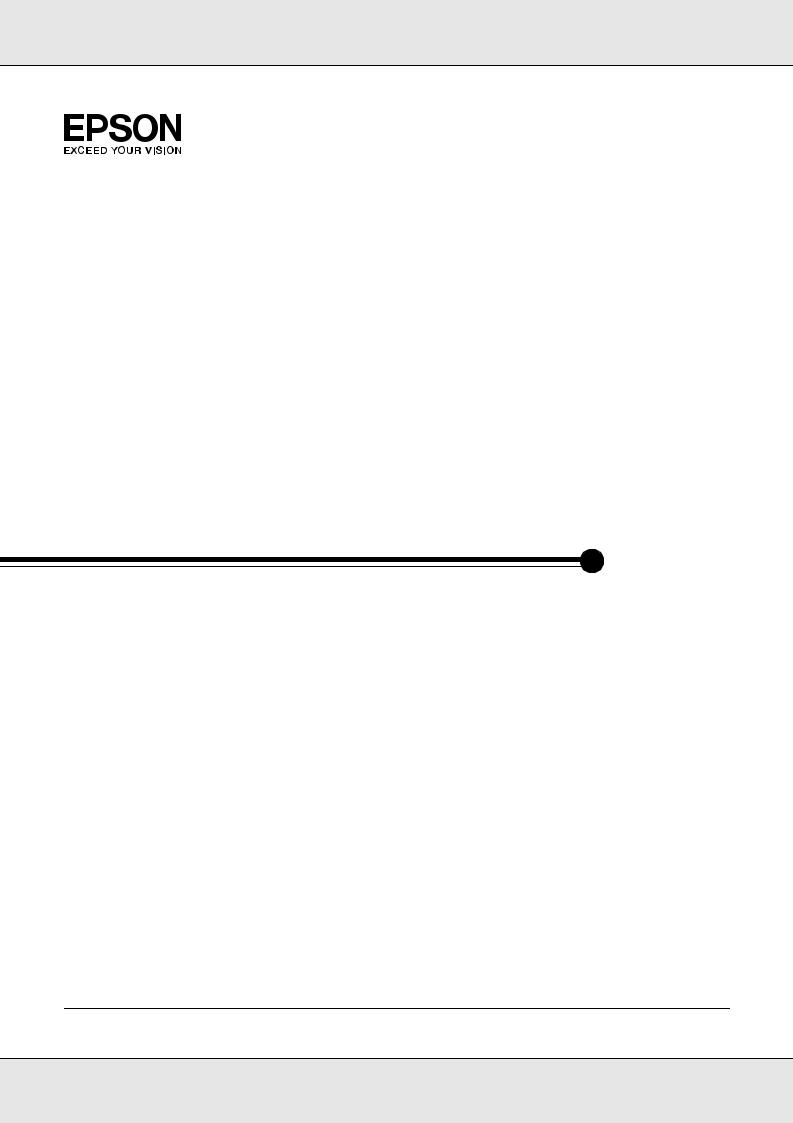
Network Guide
Network Guide
NPD2270-00
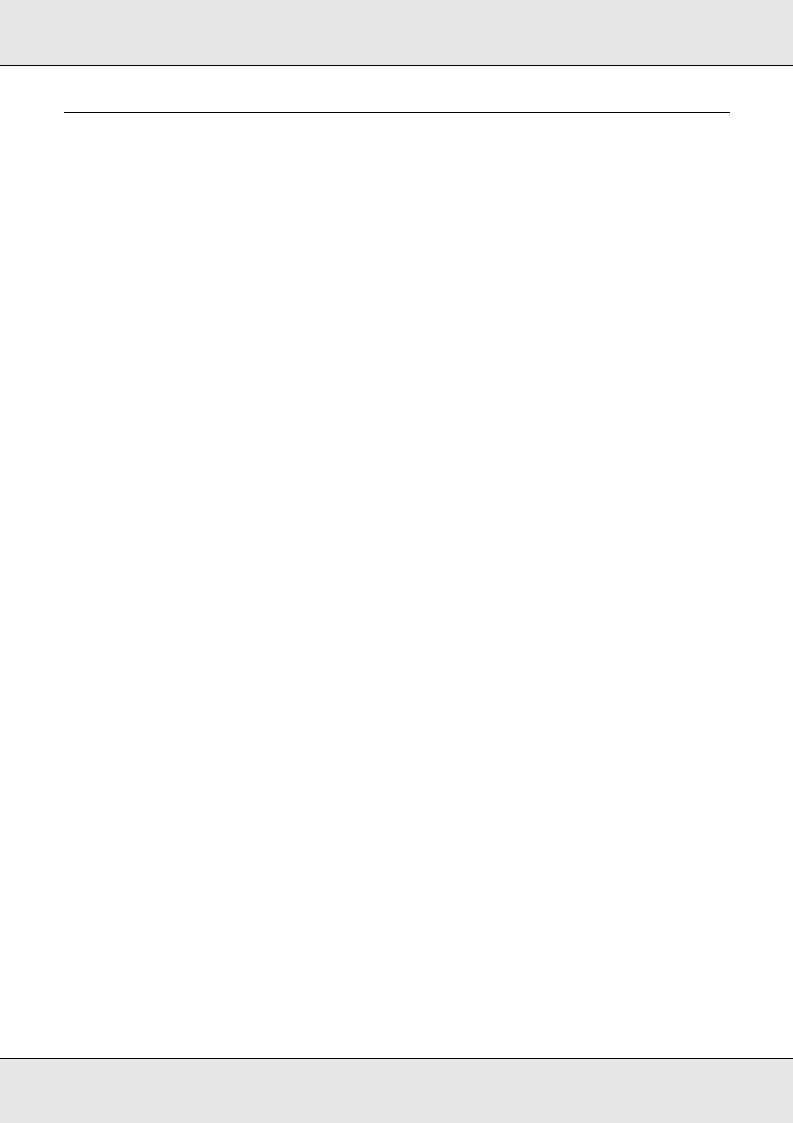
Network Guide
Copyright and Trademarks
No part of this publication may be reproduced, stored in a retrieval system, or transmitted in any form or by any means, mechanical, photocopying, recording, or otherwise, without the prior written permission of Seiko Epson Corporation. No patent liability is assumed with respect to the use of the information contained herein. Neither is any liability assumed for damages resulting from the use of the information contained herein.
Neither Seiko Epson Corporation nor its affiliates shall be liable to the purchaser of this product or third parties for damages, losses, costs, or expenses incurred by purchaser or third parties as a result of: accident, misuse, or abuse of this product or unauthorized modifications, repairs, or alterations to this product, or (excluding the U.S.) failure to strictly comply with Seiko Epson Corporation’s operating and maintenance instructions.
Seiko Epson Corporation and its affiliates shall not be liable against any damages or problems arising from the use of any options or any consumable products other than those designated as Original Epson Products or Epson Approved Products by Seiko Epson Corporation.
NEST Office Kit Copyright © 1996, Novell, Inc. All rights reserved.
EpsonNet EasyInstall and EpsonNet Config incorporates compression code from the Info-ZIP group. There are no extra charges or costs due to the use of this code, and the original compression sources are freely available from http://www.info-zip.org on the Internet.
IBM and PS/2 are registered trademarks of International Business Machines Corporation. Microsoft® and Windows® are registered trademarks of Microsoft Corporation in the United States of America and other countries. Apple® and Macintosh® are registered trademarks of Apple Computer, Inc.
EPSON and EPSON ESC/P are registered trademarks and EPSON AcuLaser and EPSON ESC/P 2 are trademarks of Seiko Epson Corporation.
Coronet is a trademark of Ludlow Industries (UK) Ltd.
Marigold is a trademark of Arthur Baker and may be registered in some jurisdictions.
CG Times and CG Omega are trademarks of Agfa Monotype Corporation and may be registered in certain jurisdictions.
Arial, Times New Roman and Albertus are trademarks of The Monotype Corporation and may be registered in certain jurisdictions.
ITC Avant Garde Gothic, ITC Bookman, ITC Zapf Chancery and ITC Zapf Dingbats are trademarks of International Typeface Corporation and may be registered in some jurisdictions.
Antique Olive is a trademark of Fonderie Olive.
Helvetica, Palatino, Times, Univers, Clarendon, New Century Schoolbook, Miriam and David are trademarks of Heidelberger Druckmaschinen AG which may be registered in certain jurisdictions.
Wingdings is a trademark of Microsoft Corporation and may be registered in some jurisdictions.
HP and HP LaserJet are registered trademarks of the Hewlett-Packard Company.
General Notice: Other product names used herein are for identification purposes only and may be trademarks of their respective owners. Epson disclaims any and all rights in those marks.
Copyright © 2006 Seiko Epson Corporation. All rights reserved.
Copyright and Trademarks 2
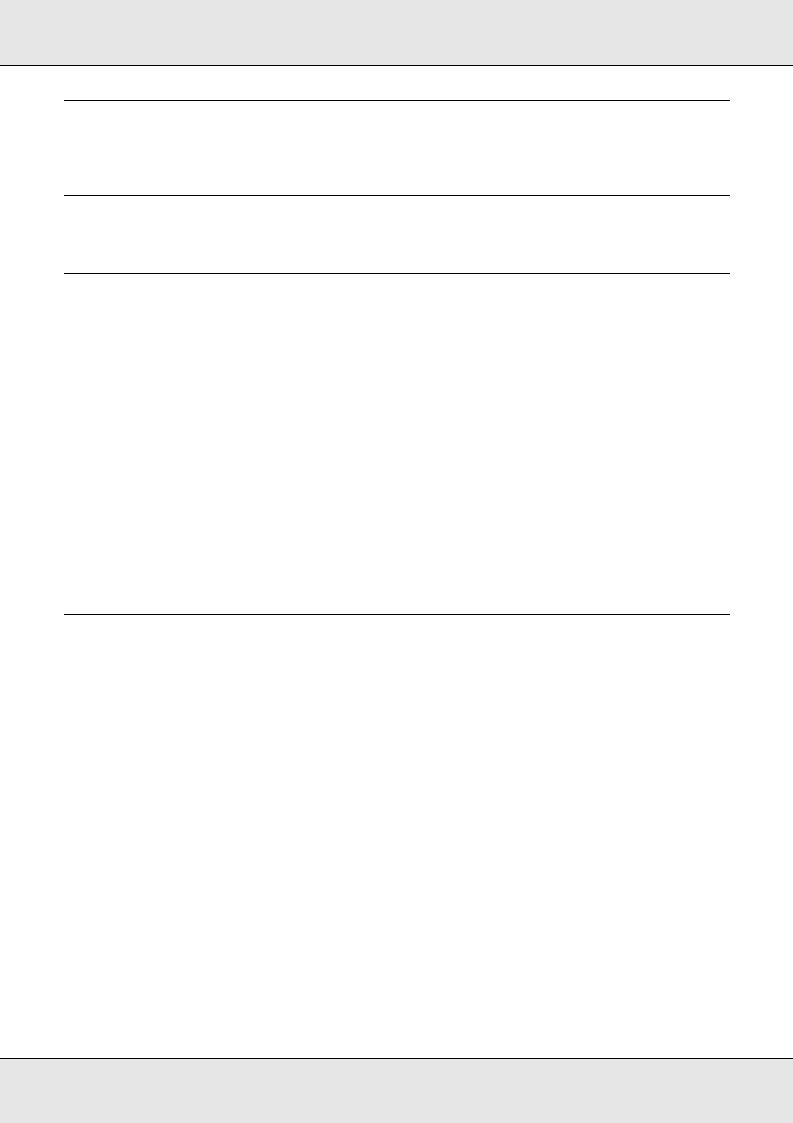
Network Guide
Contents
Copyright and Trademarks
Chapter 1 Introduction
About Your Printer . . . . . . . . . . . . . . . . . . . . . . . . . . . . . . . . . . . . . . . . . . . . . . . . . . . . . . . . . . 7
About This Guide . . . . . . . . . . . . . . . . . . . . . . . . . . . . . . . . . . . . . . . . . . . . . . . . . . . . . . . . . . . 7
Operating Environment . . . . . . . . . . . . . . . . . . . . . . . . . . . . . . . . . . . . . . . . . . . . . . . . . . . . . . 8
For users of printers supporting NetWare queue-based printing . . . . . . . . . . . . . . . . . . . 8
For users of printers not supporting NetWare queue-based printing . . . . . . . . . . . . . . . 10
Large format inkjet printers . . . . . . . . . . . . . . . . . . . . . . . . . . . . . . . . . . . . . . . . . . . . . . 11
Features of the Network Interface . . . . . . . . . . . . . . . . . . . . . . . . . . . . . . . . . . . . . . . . . . . . . 12
Network Interface Operation . . . . . . . . . . . . . . . . . . . . . . . . . . . . . . . . . . . . . . . . . . . . . . . . . 12
Status lights . . . . . . . . . . . . . . . . . . . . . . . . . . . . . . . . . . . . . . . . . . . . . . . . . . . . . . . . . . 12
Status lights (Large format inkjet printers) . . . . . . . . . . . . . . . . . . . . . . . . . . . . . . . . . . . 13
Network connector . . . . . . . . . . . . . . . . . . . . . . . . . . . . . . . . . . . . . . . . . . . . . . . . . . . . . 13
About the Software . . . . . . . . . . . . . . . . . . . . . . . . . . . . . . . . . . . . . . . . . . . . . . . . . . . . . . . . 13
Terms and Concepts . . . . . . . . . . . . . . . . . . . . . . . . . . . . . . . . . . . . . . . . . . . . . . . . . . . . . . . 14
Chapter 2 How To
Overview . . . . . . . . . . . . . . . . . . . . . . . . . . . . . . . . . . . . . . . . . . . . . . . . . . . . . . . . . . . . . . . . 15 Selecting a Printing Method. . . . . . . . . . . . . . . . . . . . . . . . . . . . . . . . . . . . . . . . . . . . . . . . . . 16 Printing from Windows . . . . . . . . . . . . . . . . . . . . . . . . . . . . . . . . . . . . . . . . . . . . . . . . . . 16 Printing from Macintosh . . . . . . . . . . . . . . . . . . . . . . . . . . . . . . . . . . . . . . . . . . . . . . . . . 16 Features of the Printing Methods. . . . . . . . . . . . . . . . . . . . . . . . . . . . . . . . . . . . . . . . . . 17 Installing Components on Your Computer. . . . . . . . . . . . . . . . . . . . . . . . . . . . . . . . . . . . . . . 19 About Installing Components on Your Computer. . . . . . . . . . . . . . . . . . . . . . . . . . . . . . 19 Windows XP. . . . . . . . . . . . . . . . . . . . . . . . . . . . . . . . . . . . . . . . . . . . . . . . . . . . . . . . . . 19 Windows Me/98 . . . . . . . . . . . . . . . . . . . . . . . . . . . . . . . . . . . . . . . . . . . . . . . . . . . . . . 21 Windows Server 2003 . . . . . . . . . . . . . . . . . . . . . . . . . . . . . . . . . . . . . . . . . . . . . . . . . . 24 Windows 2000 . . . . . . . . . . . . . . . . . . . . . . . . . . . . . . . . . . . . . . . . . . . . . . . . . . . . . . . . 26 Windows NT 4.0. . . . . . . . . . . . . . . . . . . . . . . . . . . . . . . . . . . . . . . . . . . . . . . . . . . . . . . 28 Macintosh. . . . . . . . . . . . . . . . . . . . . . . . . . . . . . . . . . . . . . . . . . . . . . . . . . . . . . . . . . . . 30 Setting Up the Network Interface. . . . . . . . . . . . . . . . . . . . . . . . . . . . . . . . . . . . . . . . . . . . . . 31 Connecting the Network Interface to the Network . . . . . . . . . . . . . . . . . . . . . . . . . . . . . 31 Configuring the Network Interface (For Windows Users). . . . . . . . . . . . . . . . . . . . . . . . 32 Configuring the Network Interface (For Macintosh Users). . . . . . . . . . . . . . . . . . . . . . . 36 Installing the Printer Driver . . . . . . . . . . . . . . . . . . . . . . . . . . . . . . . . . . . . . . . . . . . . . . . . . . 40 About Installing the Printer Driver . . . . . . . . . . . . . . . . . . . . . . . . . . . . . . . . . . . . . . . . . 40
3
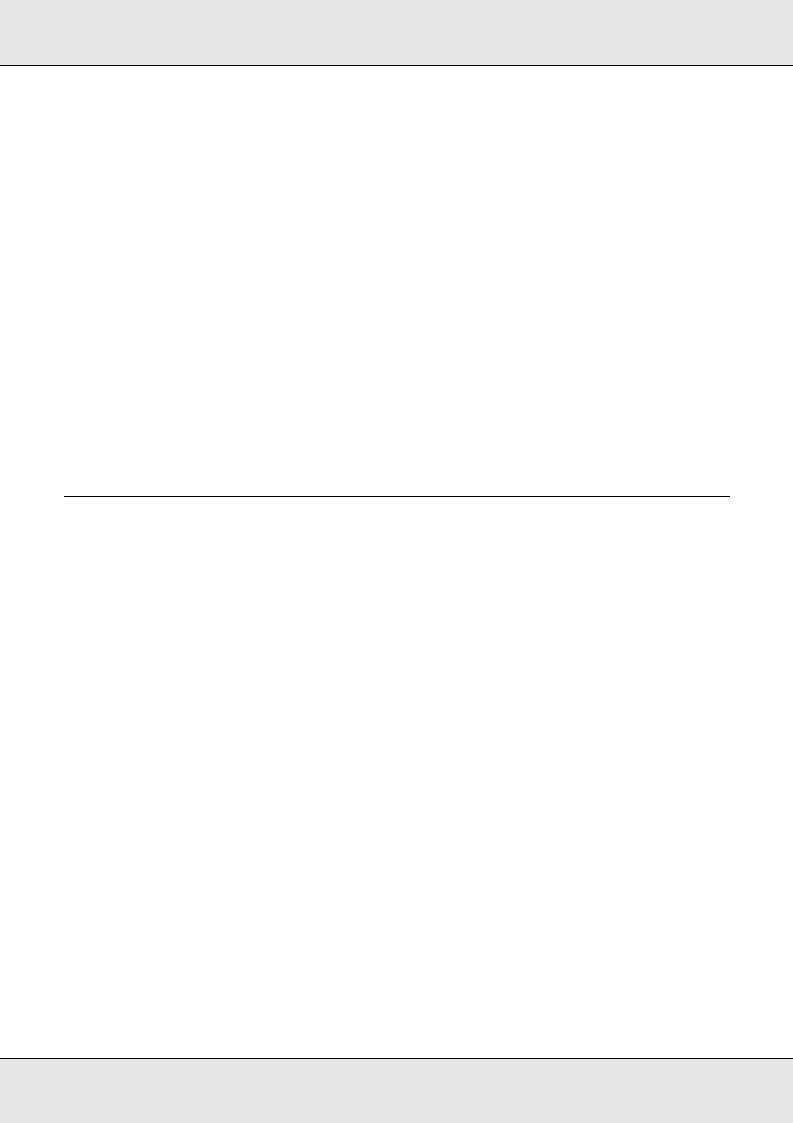
Network Guide
Windows XP. . . . . . . . . . . . . . . . . . . . . . . . . . . . . . . . . . . . . . . . . . . . . . . . . . . . . . . . . . 40 Windows Me/98 . . . . . . . . . . . . . . . . . . . . . . . . . . . . . . . . . . . . . . . . . . . . . . . . . . . . . . . 45 Windows Server 2003 . . . . . . . . . . . . . . . . . . . . . . . . . . . . . . . . . . . . . . . . . . . . . . . . . . 48 Windows 2000 . . . . . . . . . . . . . . . . . . . . . . . . . . . . . . . . . . . . . . . . . . . . . . . . . . . . . . . . 53 Windows NT 4.0. . . . . . . . . . . . . . . . . . . . . . . . . . . . . . . . . . . . . . . . . . . . . . . . . . . . . . . 57 Macintosh. . . . . . . . . . . . . . . . . . . . . . . . . . . . . . . . . . . . . . . . . . . . . . . . . . . . . . . . . . . . 60 OS/2. . . . . . . . . . . . . . . . . . . . . . . . . . . . . . . . . . . . . . . . . . . . . . . . . . . . . . . . . . . . . . . . 62
Settings for NetWare Users . . . . . . . . . . . . . . . . . . . . . . . . . . . . . . . . . . . . . . . . . . . . . . . . . . 65 Overview . . . . . . . . . . . . . . . . . . . . . . . . . . . . . . . . . . . . . . . . . . . . . . . . . . . . . . . . . . . . 65 For Users of Printers Supporting NetWare Queue-Based Printing . . . . . . . . . . . . . . . . 65 For Users of Printers Not Supporting NetWare Queue-Based Printing . . . . . . . . . . . . . 87
Settings for UNIX Users. . . . . . . . . . . . . . . . . . . . . . . . . . . . . . . . . . . . . . . . . . . . . . . . . . . . . 92 Introduction to UNIX Settings. . . . . . . . . . . . . . . . . . . . . . . . . . . . . . . . . . . . . . . . . . . . . 92 lpr filters . . . . . . . . . . . . . . . . . . . . . . . . . . . . . . . . . . . . . . . . . . . . . . . . . . . . . . . . . . . . . 92 Setting Up Different UNIX Systems Using the lpr Command . . . . . . . . . . . . . . . . . . . . 93 Using the ftp Command . . . . . . . . . . . . . . . . . . . . . . . . . . . . . . . . . . . . . . . . . . . . . . . . . 98
Chapter 3 Network Software
EpsonNet Config for Windows. . . . . . . . . . . . . . . . . . . . . . . . . . . . . . . . . . . . . . . . . . . . . . . . 99 About EpsonNet Config . . . . . . . . . . . . . . . . . . . . . . . . . . . . . . . . . . . . . . . . . . . . . . . . . 99 System Requirements . . . . . . . . . . . . . . . . . . . . . . . . . . . . . . . . . . . . . . . . . . . . . . . . . 100 Installing EpsonNet Config. . . . . . . . . . . . . . . . . . . . . . . . . . . . . . . . . . . . . . . . . . . . . . 100 Accessing the EpsonNet Config User’s Guide. . . . . . . . . . . . . . . . . . . . . . . . . . . . . . . 101
EpsonNet Config for Macintosh . . . . . . . . . . . . . . . . . . . . . . . . . . . . . . . . . . . . . . . . . . . . . . 102 About EpsonNet Config . . . . . . . . . . . . . . . . . . . . . . . . . . . . . . . . . . . . . . . . . . . . . . . . 102 System Requirements . . . . . . . . . . . . . . . . . . . . . . . . . . . . . . . . . . . . . . . . . . . . . . . . . 102 Installing EpsonNet Config. . . . . . . . . . . . . . . . . . . . . . . . . . . . . . . . . . . . . . . . . . . . . . 102 Accessing the EpsonNet Config User’s Guide. . . . . . . . . . . . . . . . . . . . . . . . . . . . . . . 103
EpsonNet Config with Web Browser . . . . . . . . . . . . . . . . . . . . . . . . . . . . . . . . . . . . . . . . . . 104 About EpsonNet Config . . . . . . . . . . . . . . . . . . . . . . . . . . . . . . . . . . . . . . . . . . . . . . . . 104 Configuring the Network Interface Using Web-Based EpsonNet Config . . . . . . . . . . . 105 Opening Screen . . . . . . . . . . . . . . . . . . . . . . . . . . . . . . . . . . . . . . . . . . . . . . . . . . . . . . 108 Information - Printer Screens . . . . . . . . . . . . . . . . . . . . . . . . . . . . . . . . . . . . . . . . . . . . 110 Configuration - Printer Screens . . . . . . . . . . . . . . . . . . . . . . . . . . . . . . . . . . . . . . . . . . 113 Information - Network Screens . . . . . . . . . . . . . . . . . . . . . . . . . . . . . . . . . . . . . . . . . . 121 Configuration - Network Screens . . . . . . . . . . . . . . . . . . . . . . . . . . . . . . . . . . . . . . . . . 122 Optional Screens . . . . . . . . . . . . . . . . . . . . . . . . . . . . . . . . . . . . . . . . . . . . . . . . . . . . . 129
EpsonNet Print. . . . . . . . . . . . . . . . . . . . . . . . . . . . . . . . . . . . . . . . . . . . . . . . . . . . . . . . . . . 130 About EpsonNet Print . . . . . . . . . . . . . . . . . . . . . . . . . . . . . . . . . . . . . . . . . . . . . . . . . 130 System Requirements . . . . . . . . . . . . . . . . . . . . . . . . . . . . . . . . . . . . . . . . . . . . . . . . . 130 Installing EpsonNet Print . . . . . . . . . . . . . . . . . . . . . . . . . . . . . . . . . . . . . . . . . . . . . . . 131 For Windows XP/Server 2003/2000/NT 4.0 Users . . . . . . . . . . . . . . . . . . . . . . . . . . . 131 For Windows Me/98/95 Users . . . . . . . . . . . . . . . . . . . . . . . . . . . . . . . . . . . . . . . . . . . 137
4

Network Guide
Configuring the Printer Port . . . . . . . . . . . . . . . . . . . . . . . . . . . . . . . . . . . . . . . . . . . . . 142 EpsonNet Internet Print . . . . . . . . . . . . . . . . . . . . . . . . . . . . . . . . . . . . . . . . . . . . . . . . . . . . 144 About EpsonNet Internet Print . . . . . . . . . . . . . . . . . . . . . . . . . . . . . . . . . . . . . . . . . . . 144 System Requirements . . . . . . . . . . . . . . . . . . . . . . . . . . . . . . . . . . . . . . . . . . . . . . . . . 144 Installing EpsonNet Internet Print . . . . . . . . . . . . . . . . . . . . . . . . . . . . . . . . . . . . . . . . 145 Setting Up Your Printer Using EpsonNet Internet Print . . . . . . . . . . . . . . . . . . . . . . . . 145 Status Alert Window. . . . . . . . . . . . . . . . . . . . . . . . . . . . . . . . . . . . . . . . . . . . . . . . . . . 151 EpsonNet WebManager . . . . . . . . . . . . . . . . . . . . . . . . . . . . . . . . . . . . . . . . . . . . . . . . . . . 151 About EpsonNet WebManager . . . . . . . . . . . . . . . . . . . . . . . . . . . . . . . . . . . . . . . . . . 151 System Requirements . . . . . . . . . . . . . . . . . . . . . . . . . . . . . . . . . . . . . . . . . . . . . . . . . 151 EpsonNet WebManager Functions . . . . . . . . . . . . . . . . . . . . . . . . . . . . . . . . . . . . . . . 152 EpsonNet WebManager Operating Structure . . . . . . . . . . . . . . . . . . . . . . . . . . . . . . . 153 Installing EpsonNet WebManager . . . . . . . . . . . . . . . . . . . . . . . . . . . . . . . . . . . . . . . . 154 Starting EpsonNet WebManager . . . . . . . . . . . . . . . . . . . . . . . . . . . . . . . . . . . . . . . . . 155 Opening the Reference Guide . . . . . . . . . . . . . . . . . . . . . . . . . . . . . . . . . . . . . . . . . . . 156 EpsonNet SetupManager . . . . . . . . . . . . . . . . . . . . . . . . . . . . . . . . . . . . . . . . . . . . . . . . . . 157 About EpsonNet SetupManager . . . . . . . . . . . . . . . . . . . . . . . . . . . . . . . . . . . . . . . . . 157 System Requirements . . . . . . . . . . . . . . . . . . . . . . . . . . . . . . . . . . . . . . . . . . . . . . . . . 158 Installing EpsonNet SetupManager . . . . . . . . . . . . . . . . . . . . . . . . . . . . . . . . . . . . . . . 159 Accessing the User’s Guide for EpsonNet SetupManager . . . . . . . . . . . . . . . . . . . . . 159
Chapter 4 Troubleshooting
General Problems . . . . . . . . . . . . . . . . . . . . . . . . . . . . . . . . . . . . . . . . . . . . . . . . . . . . . . . . 160 Cannot configure the network interface or cannot print from the network. . . . . . . . . . 160 Cannot print even if you have assigned the IP address to the computer and
the printer. . . . . . . . . . . . . . . . . . . . . . . . . . . . . . . . . . . . . . . . . . . . . . . . . . . . . . . . . 160 Unable to start EpsonNet Config. . . . . . . . . . . . . . . . . . . . . . . . . . . . . . . . . . . . . . . . . 160 The message “EpsonNet Config cannot be used because no network is installed.”
appears when you start EpsonNet Config. . . . . . . . . . . . . . . . . . . . . . . . . . . . . . . . 161 The message “Could not complete communicating configuration data” appears
when you send settings to the network interface. . . . . . . . . . . . . . . . . . . . . . . . . . . 161 Unable to start EpsonNet Config with Web Browser. . . . . . . . . . . . . . . . . . . . . . . . . . 161 Unable to set the IP address using the arp/ping commands. . . . . . . . . . . . . . . . . . . . 161 The Model Name and IP Address do not appear in the EpsonNet Config
dialog box. . . . . . . . . . . . . . . . . . . . . . . . . . . . . . . . . . . . . . . . . . . . . . . . . . . . . . . . . 162 An extra account is generated when using the dial-up network. . . . . . . . . . . . . . . . . . 162 Problems Specific to Your Network Environment . . . . . . . . . . . . . . . . . . . . . . . . . . . . . . . . 162 Windows Me/98 environment. . . . . . . . . . . . . . . . . . . . . . . . . . . . . . . . . . . . . . . . . . . . 162 Windows 2000/NT environment. . . . . . . . . . . . . . . . . . . . . . . . . . . . . . . . . . . . . . . . . . 163 Macintosh environment . . . . . . . . . . . . . . . . . . . . . . . . . . . . . . . . . . . . . . . . . . . . . . . . 164 NetWare environment . . . . . . . . . . . . . . . . . . . . . . . . . . . . . . . . . . . . . . . . . . . . . . . . . 164 Printing a Network Status Sheet . . . . . . . . . . . . . . . . . . . . . . . . . . . . . . . . . . . . . . . . . . . . . 166 Initializing Your Printer. . . . . . . . . . . . . . . . . . . . . . . . . . . . . . . . . . . . . . . . . . . . . . . . . . . . . 166
5
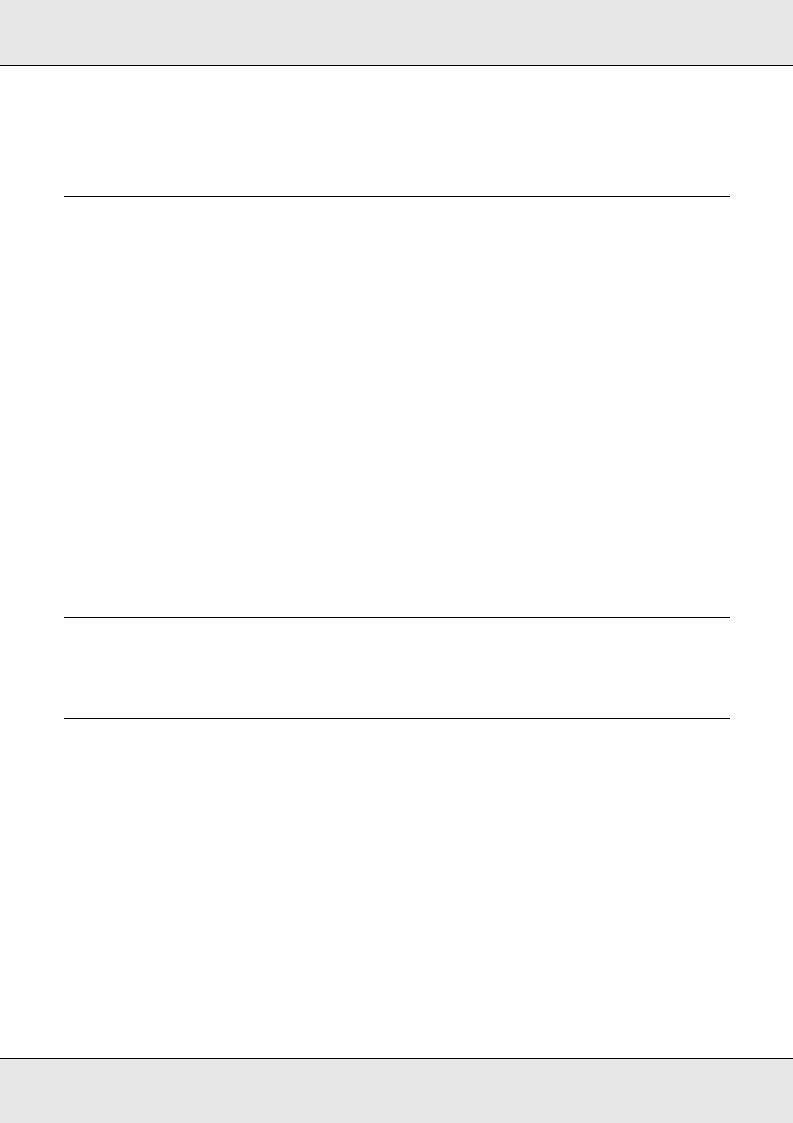
Network Guide
Reformatting the Hard Disk Drive . . . . . . . . . . . . . . . . . . . . . . . . . . . . . . . . . . . . . . . . . . . . 167
Chapter 5 Tips for Administrator
Setting an IP Address on the Printer’s Control Panel . . . . . . . . . . . . . . . . . . . . . . . . . . . . . 168 Network Menu . . . . . . . . . . . . . . . . . . . . . . . . . . . . . . . . . . . . . . . . . . . . . . . . . . . . . . . 169 AUX Menu . . . . . . . . . . . . . . . . . . . . . . . . . . . . . . . . . . . . . . . . . . . . . . . . . . . . . . . . . . 170 Setting an IP Address on the Printer’s Control Panel (Large Format Inkjet Printers) . . . . . 171 Network Setup Menu . . . . . . . . . . . . . . . . . . . . . . . . . . . . . . . . . . . . . . . . . . . . . . . . . . 172 Setting an IP Address Using the arp/ping Command . . . . . . . . . . . . . . . . . . . . . . . . . . . . . 173 Checking the LAN . . . . . . . . . . . . . . . . . . . . . . . . . . . . . . . . . . . . . . . . . . . . . . . . . . . . 173 Setting and checking the new IP address . . . . . . . . . . . . . . . . . . . . . . . . . . . . . . . . . . 174 Distributing the Printer Driver Automatically . . . . . . . . . . . . . . . . . . . . . . . . . . . . . . . . . . . . 175 EpsonNet SetupManager. . . . . . . . . . . . . . . . . . . . . . . . . . . . . . . . . . . . . . . . . . . . . . . 175 EpsonNet NDPS Gateway . . . . . . . . . . . . . . . . . . . . . . . . . . . . . . . . . . . . . . . . . . . . . . 175 Instructions on Using a Dial-Up Router . . . . . . . . . . . . . . . . . . . . . . . . . . . . . . . . . . . . . . . . 175 Function of Universal Plug and Play . . . . . . . . . . . . . . . . . . . . . . . . . . . . . . . . . . . . . . . . . . 176 Uninstalling Software . . . . . . . . . . . . . . . . . . . . . . . . . . . . . . . . . . . . . . . . . . . . . . . . . . . . . . 176 Windows Me/98/95/2000/NT 4.0 . . . . . . . . . . . . . . . . . . . . . . . . . . . . . . . . . . . . . . . . . 176 Windows XP/Server 2003 . . . . . . . . . . . . . . . . . . . . . . . . . . . . . . . . . . . . . . . . . . . . . . 177 Macintosh. . . . . . . . . . . . . . . . . . . . . . . . . . . . . . . . . . . . . . . . . . . . . . . . . . . . . . . . . . . 177
Appendix A Safety Instructions
Warnings, Cautions, and Notes . . . . . . . . . . . . . . . . . . . . . . . . . . . . . . . . . . . . . . . . . . . . . . 178
Index
6
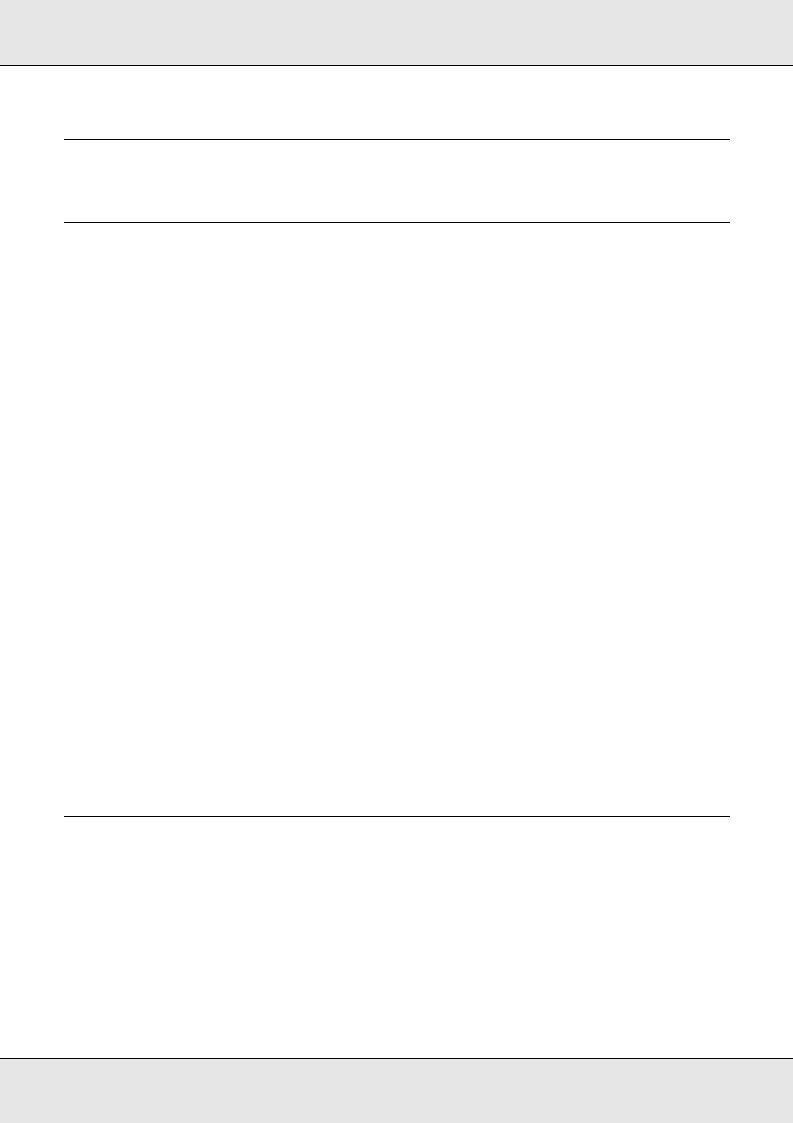
Network Guide
Chapter 1
Introduction
About Your Printer
Your printer has a built-in Ethernet interface and can connect anywhere on your network using 10Base-T or 100Base-TX. The built-in Ethernet interface, which is called the network interface in this manual, automatically selects the correct standard when it connects to a network. In addition, it supports and automatically selects the IEEE 802.2, IEEE 802.3,
Ethernet II, and Ethernet SNAP network protocols.
Because the network interface supports multiple protocols and automatically detects protocols on your network, you can print from Microsoft® Windows®, Apple® Macintosh®, UNIX®, and IBM® OS/2 applications.
Use the Software CD-ROM to easily configure the network interface for use on the TCP/IP network and install the printer driver. You can use the printer on the TCP/IP network at once.
If you want to configure the network interface for protocols such as TCP/IP, NetWare,
NetBEUI, AppleTalk®, IPP, and SNMP, use EpsonNet Config, the configuration utility provided with your product, to quickly and easily configure the network interface to use those protocols.
Note:
The EpsonNet Config utility configures the network interface to work only with protocols that exist on your network. This does not imply that you can use all of the above-mentioned protocols on your network or operating system. The protocols that the network interface can use may vary depending on the operating system and the network configuration.
Some printers do not support NetWare queue-based printing. See the manual shipped with your printer for details.
About This Guide
This Network Guide contains information about using the network interface on a network.
It includes how to set up the network interface, install the configuration software, and modify network settings of your printer and computers.
For information about your printer, see your User’s Guide.
Introduction 7
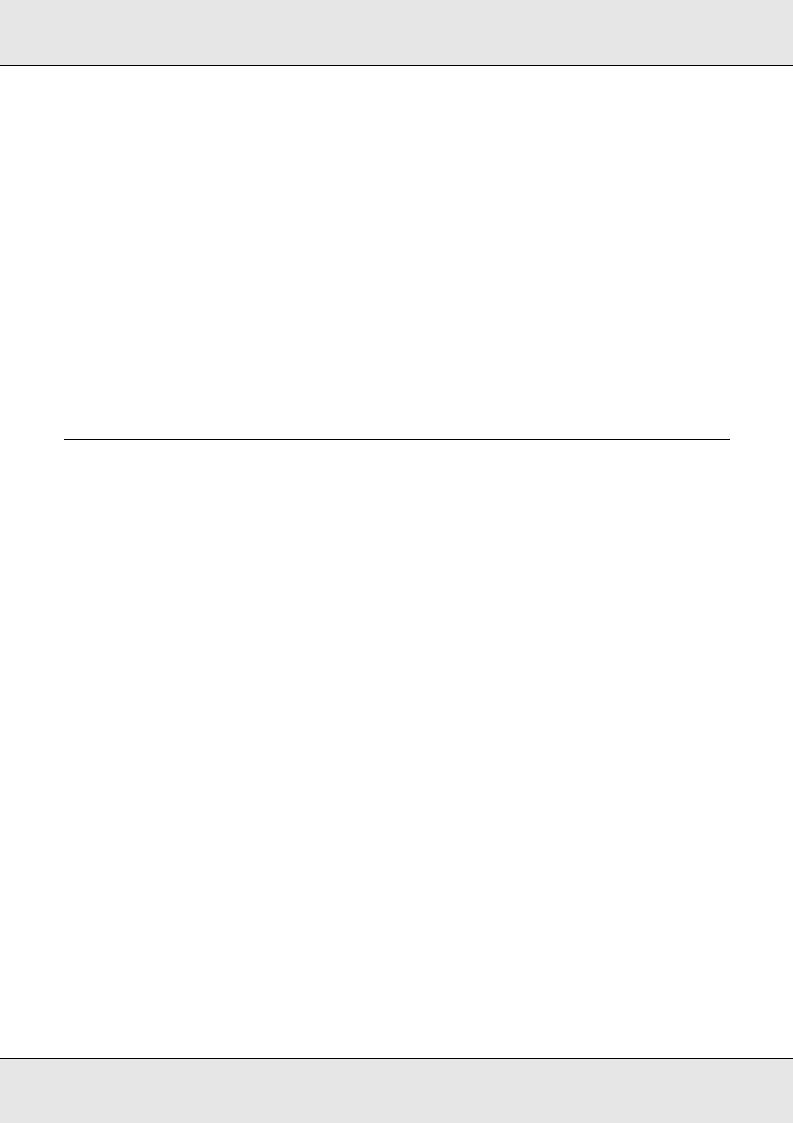
Network Guide
Note:
To read the online guide, you must have Microsoft Internet Explorer 4.0 (or later) or Netscape Navigator 4.0 (or later) installed on your computer.
This guide is written for network administrators, and many of the steps included here require detailed network knowledge and administrator rights.
The term “network administrator” refers to the person responsible for maintaining the network. “Administrator” is synonymous with “Supervisor” in this guide.
The term “network interface” refers to the built-in Ethernet interface of the printer in this guide.
Some screen shots in this guide may list a printer name other than your printer. This difference does not alter the instructions.
The supported operating systems are different depending on the printer. See your printer’s User’s Guide for the supported operating systems.
Operating Environment
The network interface supports the following environments.
For users of printers supporting NetWare queue-based printing
OS |
Version |
Protocol |
|
|
|
Windows 98 |
- |
TCP/IP (using EpsonNet Print) |
Windows 98 SE |
|
|
|
IPP |
|
|
|
|
|
|
(using EpsonNet Internet Print) |
|
|
|
|
|
NetBEUI |
|
|
|
Windows Me |
- |
TCP/IP (using EpsonNet Print) |
|
|
|
|
|
IPP |
|
|
|
|
|
NetBEUI |
|
|
|
Windows XP |
- |
TCP/IP (using LPR, Standard |
(Home, Professional, |
|
TCP/IP Port, or EpsonNet Print) |
Professional x64) |
|
|
|
IPP |
|
Windows Server 2003 |
|
|
|
|
|
Windows Server 2003 x64 |
|
|
Edition |
|
|
Windows 2000 |
|
|
(Professional, Server) |
|
|
|
|
|
Introduction 8
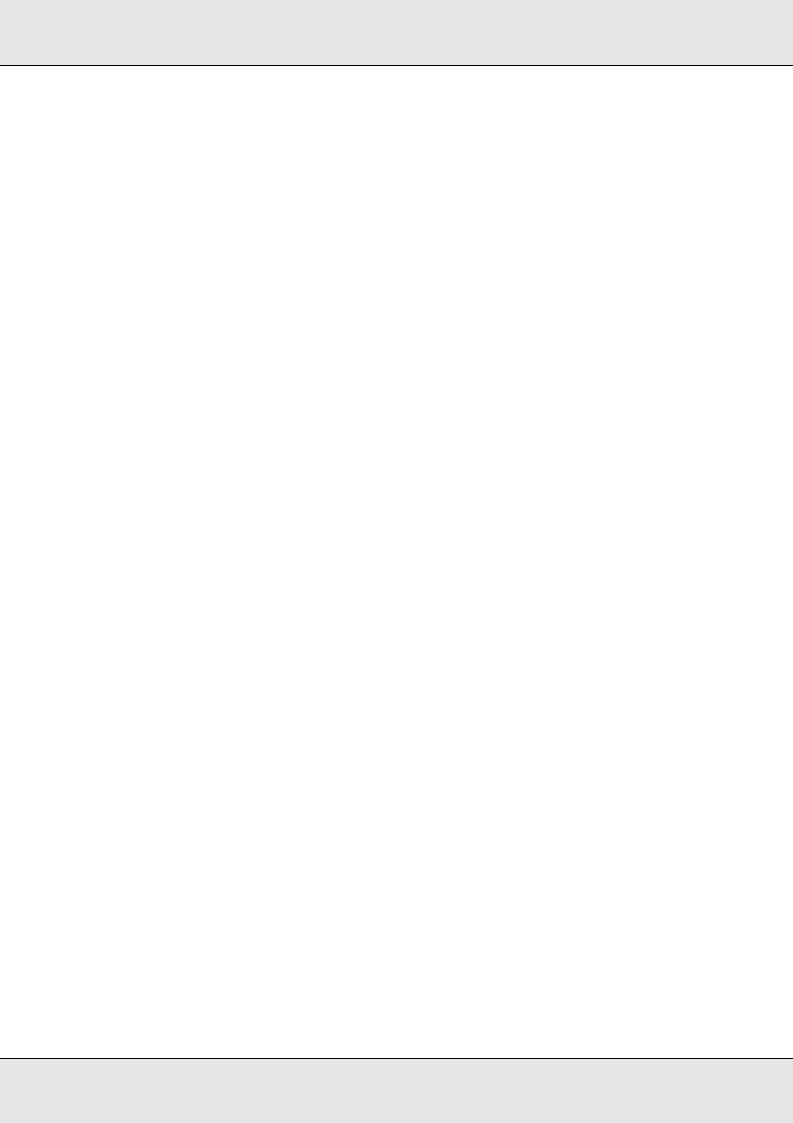
Network Guide
Windows NT 4.0 with Service |
- |
TCP/IP |
Pack 5 or higher |
|
(using LPR or EpsonNet Print) |
|
|
|
|
|
IPP |
|
|
(using EpsonNet Internet Print) |
|
|
|
|
|
NetBEUI |
|
|
|
Macintosh |
Mac OS X 10.4 or later |
Bonjour |
|
|
|
|
|
TCP/IP |
|
|
|
|
|
AppleTalk |
|
|
|
|
Mac OS X 10.2.4 or later |
Rendezvous |
|
|
|
|
|
TCP/IP |
|
|
|
|
|
AppleTalk |
|
|
|
|
Mac OS X 10.2 or later |
TCP/IP |
|
|
|
|
|
AppleTalk |
|
|
|
|
Mac 9.1 or later |
AppleTalk |
|
|
|
NetWare |
3.x |
Bindery mode |
|
|
|
|
4.x/IntranetWare |
NDS mode |
|
|
|
|
|
Bindery emulation mode |
|
|
|
|
5.x/6.x |
NDS Queue-based print |
|
|
system |
|
|
|
|
|
NDPS |
|
|
|
OS/2 (OS/2 Warp Connect, |
V3 V4 |
TCP/IP (lprportd) |
OS/2 Warp Server) |
|
|
|
NetBEUI |
|
|
|
|
|
|
|
UNIX |
Sun OS 4.1.4 or later: SPARC |
lpr, ftp |
|
|
|
|
SunSoft Solaris 2.4 or later: |
|
|
SPARC and x86 |
|
|
SCO UNIX 4.2 or later |
|
|
|
|
|
SCO UnixWare 2.01 or later |
|
|
|
|
|
HP/UX 9.05 or later |
|
|
|
|
|
IBM AIX 3.2.5 or later and |
|
|
4.1.3 or later |
|
|
|
|
Note:
Only the Intel version of Windows NT is supported.
The multi-user environment of Mac OS 9 is not supported.
If you use the printer in a dial-up router environment, you must set an IP address for the printer. Make sure the IP address is suitable for the segment; incorrect IP address may generate unexpected dial-up.
Introduction 9

Network Guide
For users of printers not supporting NetWare queue-based printing
OS |
Version |
Protocol |
|
|
|
Windows 98 |
- |
TCP/IP (using EpsonNet Print) |
Windows 98 SE |
|
|
|
IPP |
|
|
|
|
|
|
(using EpsonNet Internet Print) |
|
|
|
|
|
NetBEUI |
|
|
|
Windows Me |
- |
TCP/IP (using EpsonNet Print) |
|
|
|
|
|
IPP |
|
|
|
|
|
NetBEUI |
|
|
|
Windows XP |
- |
TCP/IP (using LPR, Standard |
(Home, Professional, |
|
TCP/IP Port, or EpsonNet Print) |
Professional x64) |
|
|
|
IPP |
|
Windows Server 2003 |
|
|
|
|
|
Windows Server 2003 x64 |
|
|
Edition |
|
|
Windows 2000 |
|
|
(Professional, Server) |
|
|
|
|
|
Windows NT 4.0 with Service |
- |
TCP/IP |
Pack 5 or higher |
|
(using LPR or EpsonNet Print) |
|
|
|
|
|
IPP |
|
|
(using EpsonNet Internet Print) |
|
|
|
|
|
NetBEUI |
|
|
|
Macintosh |
Mac OS X 10.4 or later |
Bonjour |
|
|
|
|
|
TCP/IP |
|
|
|
|
|
AppleTalk |
|
|
|
|
Mac OS X 10.2.4 or later |
Rendezvous |
|
|
|
|
|
TCP/IP |
|
|
|
|
|
AppleTalk |
|
|
|
|
Mac OS X 10.2 or later |
TCP/IP |
|
|
|
|
|
AppleTalk |
|
|
|
|
Mac 9.1 or later |
AppleTalk |
|
|
|
NetWare |
5.x/6.x |
NDPS (using EpsonNet NDPS |
|
|
Gateway) |
|
|
|
OS/2 (OS/2 Warp Connect, |
V3 V4 |
TCP/IP (lprportd) |
OS/2 Warp Server) |
|
|
|
NetBEUI |
|
|
|
|
|
|
|
Introduction 10
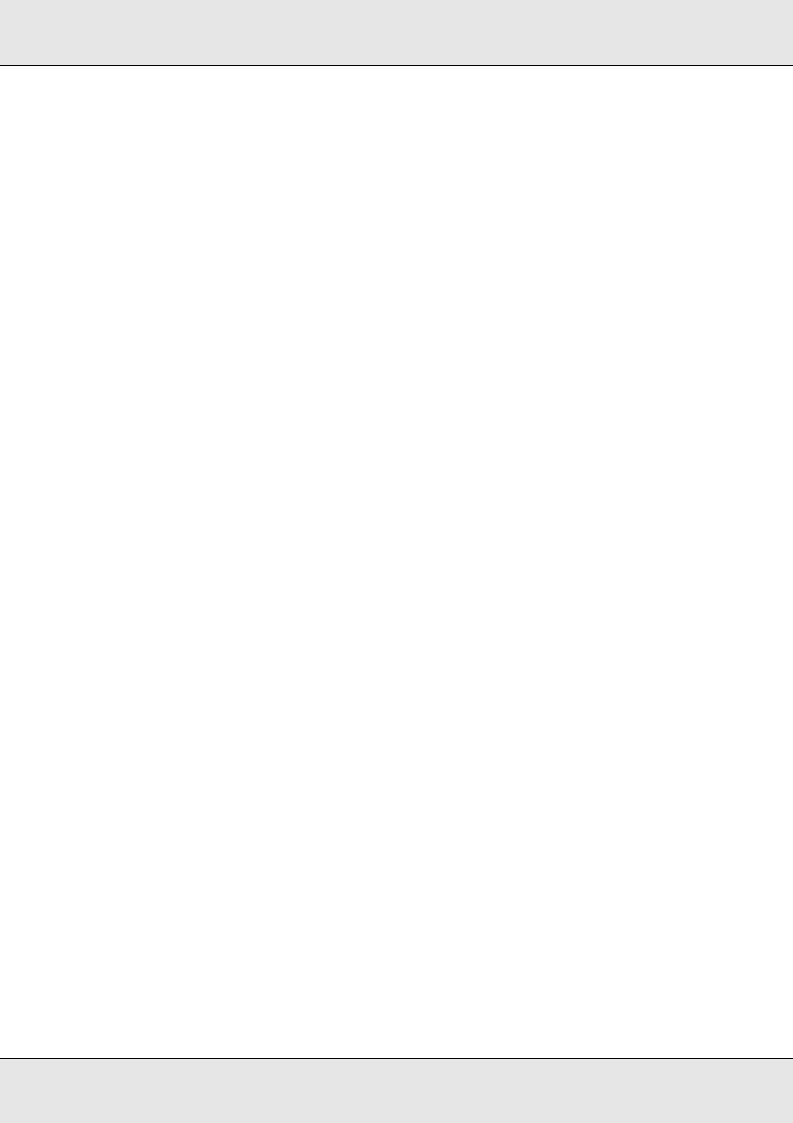
Network Guide
UNIX |
Sun OS 4.1.4 or later: SPARC |
lpr, ftp |
|
|
|
|
SunSoft Solaris 2.4 or later: |
|
|
SPARC and x86SCO UNIX |
|
|
4.2 or later |
|
|
|
|
|
SCO UnixWare 2.01 or later |
|
|
|
|
|
HP/UX 9.05 or later |
|
|
|
|
|
IBM AIX 3.2.5 or later and |
|
|
4.1.3 or later |
|
|
|
|
Note:
Only the Intel version of Windows NT is supported.
The multi-user environment of Mac OS 9 is not supported.
If you use the printer in a dial-up router environment, you must set an IP address for the printer. Make sure the IP address is suitable for the segment; incorrect IP address may generate unexpected dial-up.
Large format inkjet printers
OS |
Version |
Protocol |
|
|
|
Windows XP |
- |
TCP/IP (using LPR, Standard |
(Home, Professional, |
|
TCP/IP Port, or EpsonNet Print) |
Professional x64) |
|
|
|
IPP |
|
Windows 2000 |
|
|
|
|
|
(Professional, Server) |
|
|
|
|
|
Macintosh |
Mac OS X 10.4 or later |
Bonjour |
|
|
|
|
|
TCP/IP |
|
|
|
|
|
AppleTalk |
|
|
|
|
Mac OS X 10.2.8 or later |
Rendezvous |
|
|
|
|
|
TCP/IP |
|
|
|
|
|
AppleTalk |
|
|
|
Introduction 11
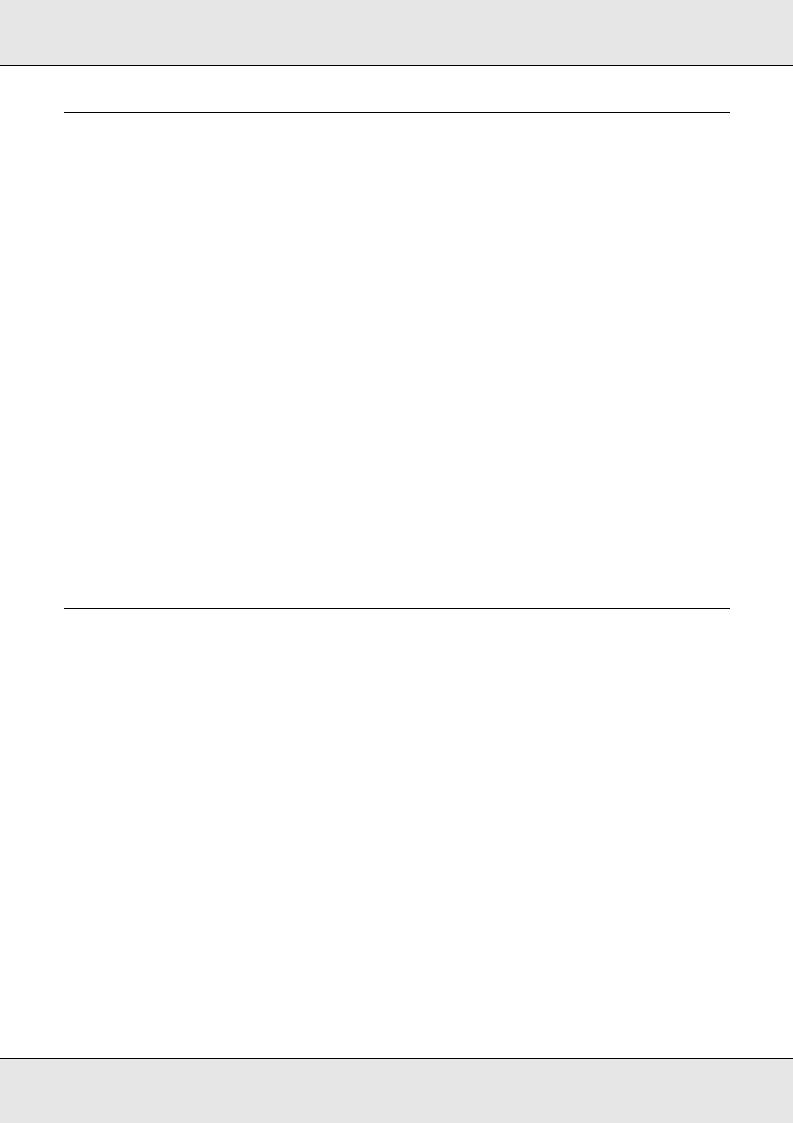
Network Guide
Features of the Network Interface
Connects your Epson printer using a built-in Ethernet interface, which is called the network interface in this manual, to the network.
Supports multiple protocols, such as TCP/IP, NetWare, NetBEUI, AppleTalk, and IPP.
Supports both 10Base-T and 100Base-TX.
Supports DHCP.
Supports Automatic Private IP Addressing (APIPA) that assigns an IP address automatically to the network interface even if there is no DHCP server on the network.
Supports the Dynamic DNS function.
Supports SNMP and MIB.
Supports SNTP (Simple Network Time Protocol).
Supports Rendezvous on Mac OS X 10.2.4 or later.
Supports Bonjour on Mac OS X 10.4 or later.
Network Interface Operation
Status lights
The indicator lights (one green and one orange) provide you with important information on the operations of the network interface.
The green light is a data transmission light that flashes when the host interface receives data.
The orange light indicates whether the network interface is connected to 10Base-T or 100Base-TX. The light is on when the connection is 100Base-TX, or off when the connection is 10Base-T.
Introduction 12
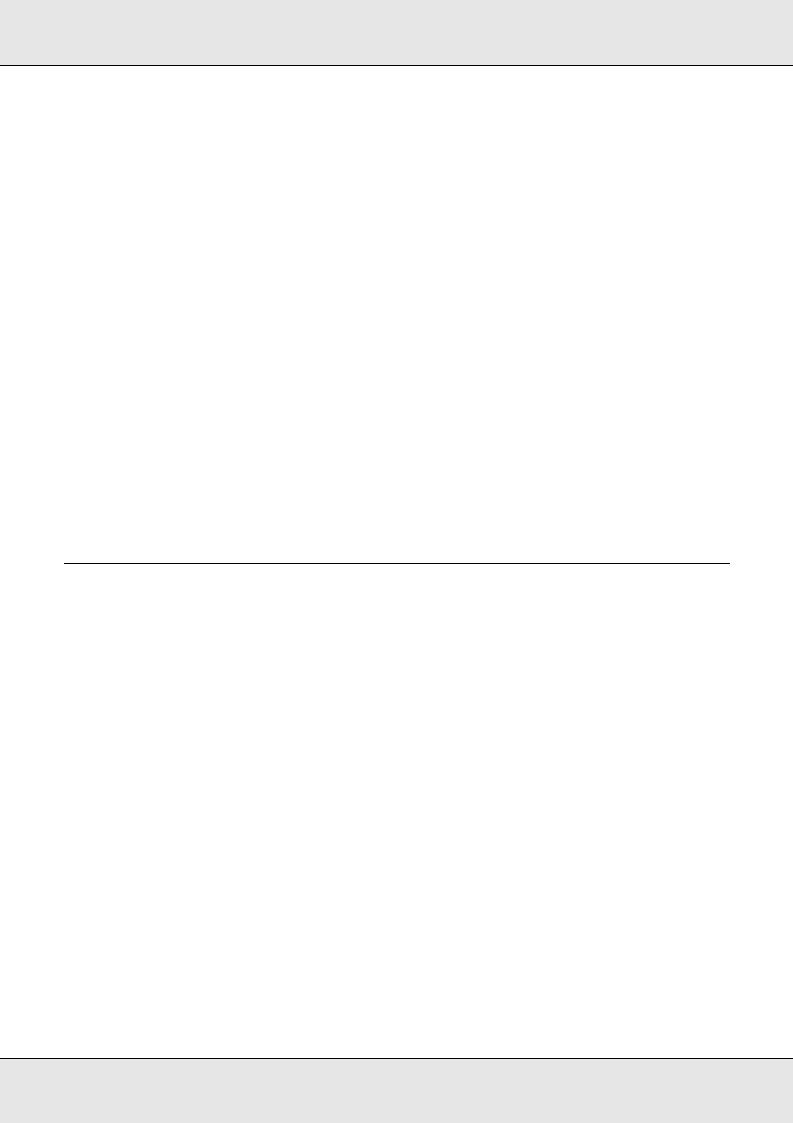
Network Guide
Status lights (Large format inkjet printers)
The indicator lights provide you with important information on the operations of the network interface.
The light on the left side indicates whether the network interface is connected to 10Base-T or 100Base-TX. The light is orange when the connection is 100Base-TX, or green when the connection is 10Base-T.
The light on the right side is a data transmission light that flashes when the host interface receives data.
Network connector
RJ-45 connector: This connector is used to connect an Ethernet cable to a network. You can use this cable for both 10Base-T and 100Base-TX.
cCaution:
You must use a Category-5 shielded twisted-pair cable to connect the network interface to a network to prevent malfunctions.
About the Software
The software CD-ROM provided with your printer includes the following network software.
Note:
The software provided varies depending on your printer model.
EpsonNet Config for Windows is a Windows-based configuration utility for administrators that allows you to configure the network interface for various protocols such as TCP/IP, NetWare, MS Network, AppleTalk, IPP, and SNMP. See “EpsonNet
Config for Windows” on page 99.
EpsonNet Config for Macintosh is a Macintosh-based configuration utility for administrators that allows you to configure the network interface for TCP/IP, AppleTalk, and IPP. See “EpsonNet Config for Macintosh” on page 102.
EpsonNet Config with Web Browser is a Web-based configuration utility that allows you to configure the network interface for TCP/IP, NetWare, MS Network, AppleTalk, IPP, and SNMP. See “EpsonNet Config with Web Browser” on page 104.
EpsonNet Print is a utility that enables TCP/IP printing for Windows. (Windows XP/Server 2003/2000/NT 4.0 also support OS standard LPR printing.) See “EpsonNet
Print” on page 130.
Introduction 13

Network Guide
EpsonNet Internet Print is a utility that supports printing across the Internet using
Internet Printing Protocol for Windows 98/95/NT 4.0. See “EpsonNet Internet Print” on page 144.
EpsonNet WebManager is a Web-based utility that helps network administrators to easily manage network devices. See “EpsonNet WebManager” on page 151.
EpsonNet SetupManager is a utility that provides a simple printer installation and configuration tool for network administrators, and an easy network printer installation process for clients. See “About EpsonNet SetupManager” on page 157.
EpsonNet NDPS Gateway is a gateway utility that you can use to print and monitor the printer status of the Epson printer in the NDPS (Novell Distributed Print Services) environment of NetWare.
For users of printers supporting NetWare Queue-Based Printing, “Using the EpsonNet
NDPS Gateway” on page 78.
For users of printers not supporting NetWare Queue-Based Printing, “Using the
EpsonNet NDPS Gateway” on page 88.
Terms and Concepts
Configuration -- a prepared set of conditions for proper operation of a device. Configuring the network interface is to prepare it to work with protocols available on a network.
DHCP -- a dynamic host configuration protocol. It is a protocol that assigns dynamic IP addresses to devices on a network.
EtherTalk -- the communication protocol of AppleTalk governing Ethernet transmissions ftp -- a TCP/IP application protocol for file transfer
lpd -- a TCP/IP remote printing protocol application
Print queue -- a location where a print job is stored as a file, until the network interface sends the job to the assigned printer
Protocol -- a rule that controls how data or information is exchanged through a network. Computers and software cannot communicate with each other using different protocols.
Remote printer -- a shared printer connected elsewhere on the network, but under the control of a NetWare print server
TCP/IP -- Transmission Control Protocol/Internet Protocol, a layer of protocols that provides communication between nodes on a network
Introduction 14
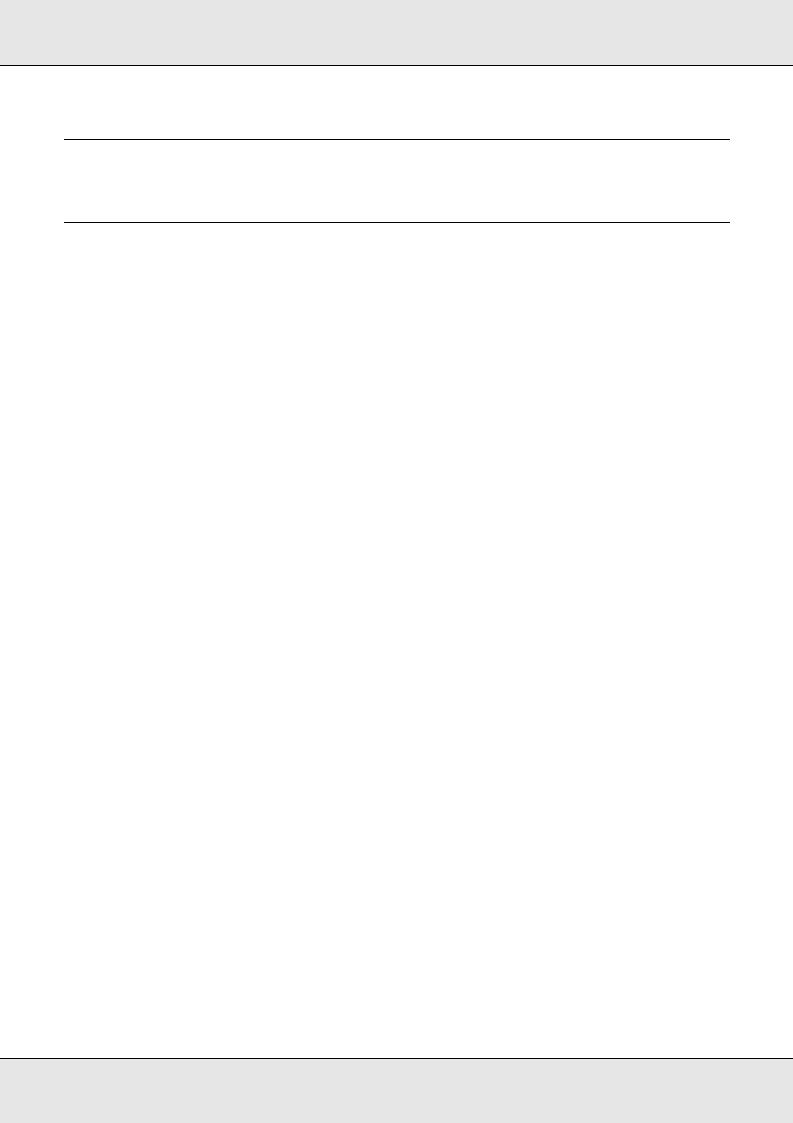
Network Guide
Chapter 2
How To
Overview
This section describes the general procedure on how to set up the network interface for use on a network.
1.Check the network interface operation.
Check the functions and operations of the network interface, such as status lights and
RJ-45 connector. See “Network Interface Operation” on page 12 for details.
2.Select a printing method.
Select a printing method appropriate for your network environment and operating system. If you are not sure, see “Printing from Windows” on page 16 or “Printing from
Macintosh” on page 16 for details.
3.Install the necessary components on your computer.
Make sure the necessary components (such as TCP/IP, NetBEUI, etc.) are installed on the computer, and network settings (such as IP address, subnet mask, etc.) of the computer is set. See “About Installing Components on Your Computer” on page 19 for details.
4.Connect the network interface to the network.
Connect the network interface to the network. See “Connecting the Network Interface to the Network” on page 31 for details.
5.Configure the network interface and install the printer driver.
See “Configuring the Network Interface (For Windows Users)” on page 32 or
“Configuring the Network Interface (For Macintosh Users)” on page 36 for details.
6.If necessary, configure the network settings of the network interface using EpsonNet
Config.
Configure the network interface for TCP/IP, AppleTalk, MS Network, etc. using
EpsonNet Config. For Windows users, see “About EpsonNet Config” on page 99. For Macintosh users, see “About EpsonNet Config” on page 102.
How To 15
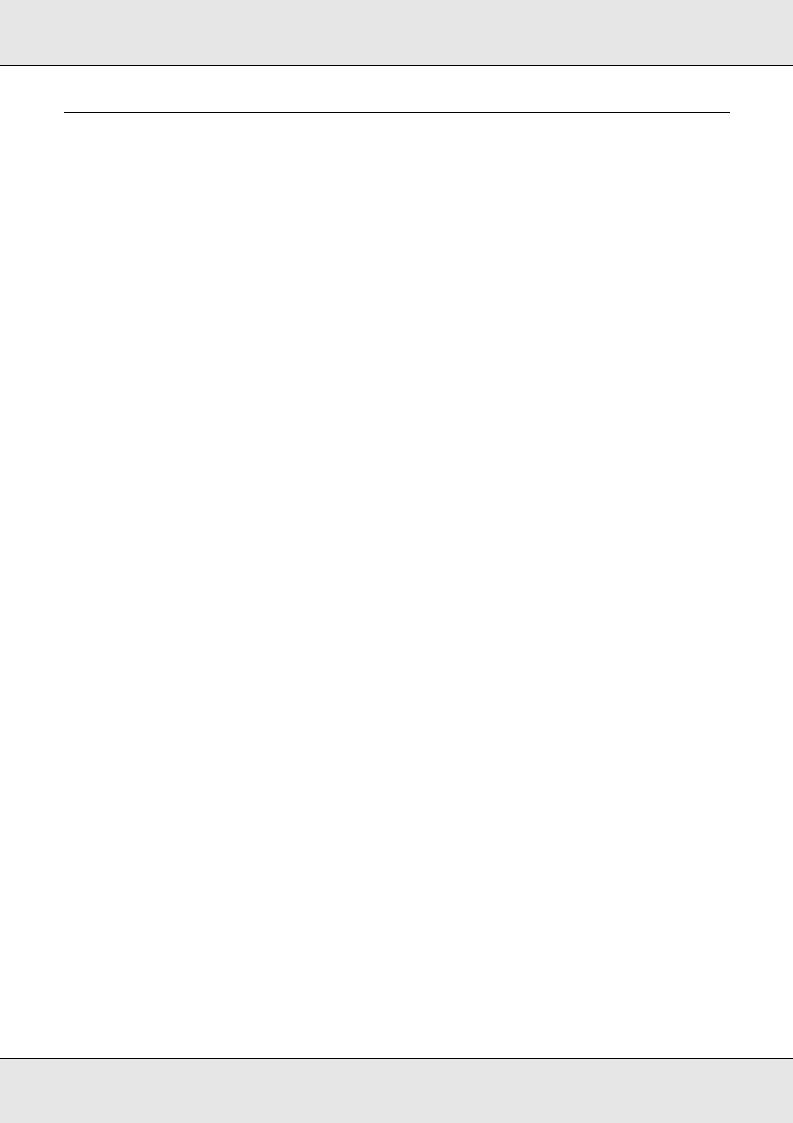
Network Guide
Selecting a Printing Method
Printing from Windows
Check if there is a Windows XP/Server 2003/2000/NT print server on your network, and then use the suggestions below.
Note:
Only the recommended printing methods are introduced here. See “Features of the Printing Methods” on page 17 for information on additional methods.
If no Windows XP/Server 2003/2000/NT print server exists
Use a printing method appropriate to your operating system:
For Windows Me/98
We recommend TCP/IP printing via EpsonNet Print. See “About EpsonNet Print” on page 130.
For Windows XP/Server 2003/2000/NT
We recommend TCP/IP printing via LPR. See “Windows XP” on page 40, “Windows
Server 2003” on page 48, “Windows 2000” on page 53, or “Windows NT 4.0” on page 57.
If a Windows XP/Server 2003/2000/NT print server exists
On the server, set the printer to connect with LPR and turn it into a shared printer. Your clients can then print to this shared printer.
Printing from Macintosh
Mac OS X 10.4 or later
Bonjour
EPSON TCP/IP
EPSON AppleTalk
How To 16
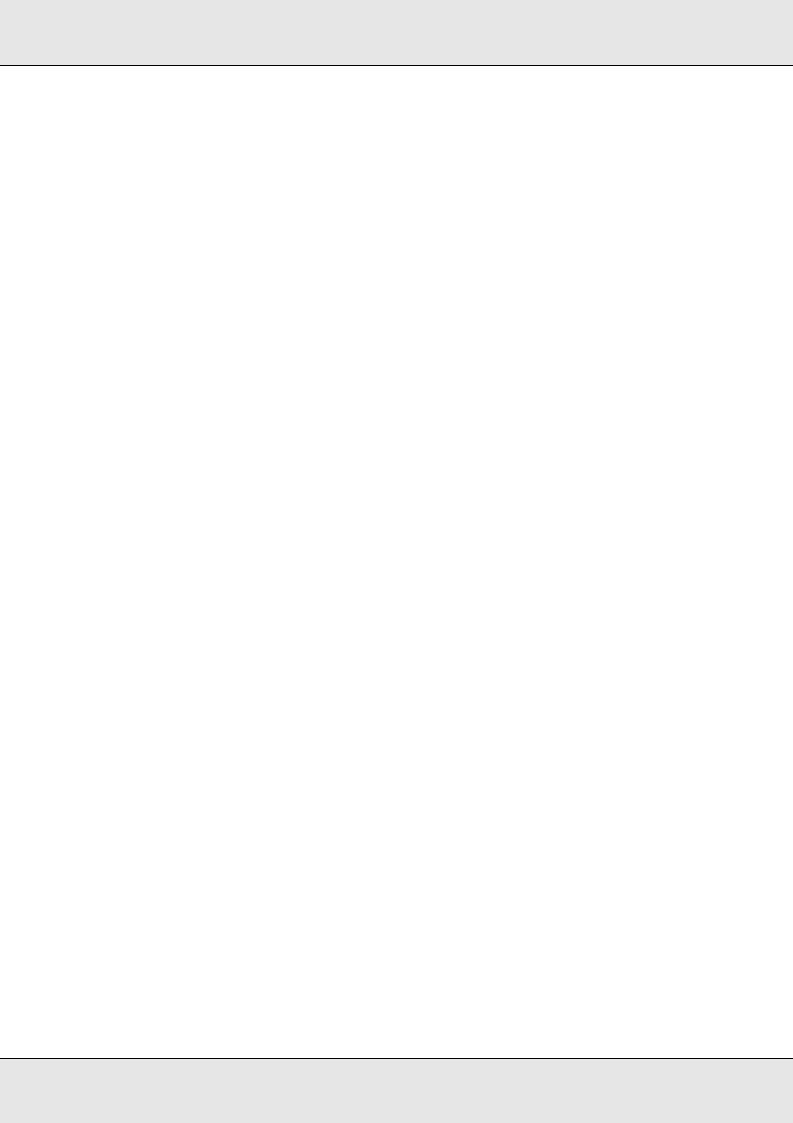
Network Guide
Mac OS X 10.2.4 or later
Rendezvous
EPSON TCP/IP
EPSON AppleTalk
Mac OS X 10.2 or later
EPSON TCP/IP
EPSON AppleTalk
Mac OS 9
AppleTalk
Features of the Printing Methods
This section describes features of the printing methods available for you to choose.
LPR (TCP/IP) printing
Advantages
No computer as a network interface is required.
No special utility for Windows XP/Server 2003/2000/NT is required.
You can see the printer status using EPSON Status Monitor.
For Windows XP/Server 2003/2000/NT, you can create a print log using the event viewer.
You can print via a router.
Disadvantages
You need to set up TCP/IP.
For Windows Me/98, EpsonNet Print must be installed on all computers to use for printing.
How To 17
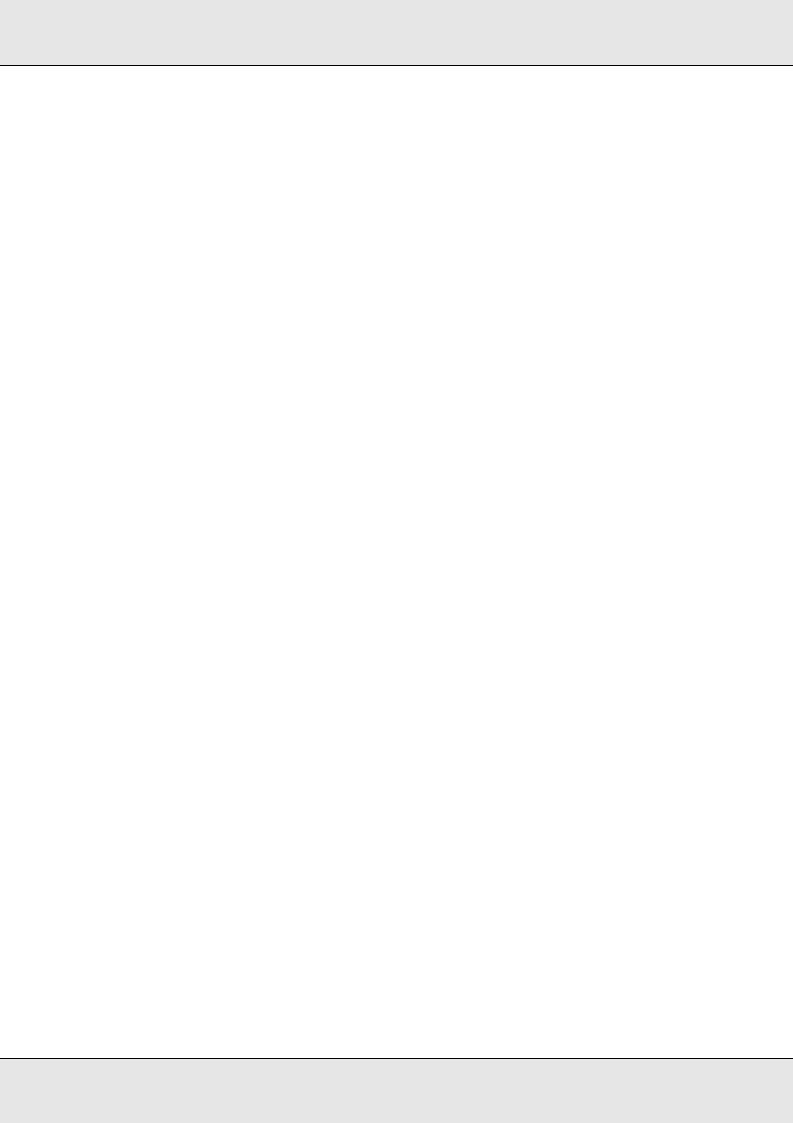
Network Guide
Internet printing
Advantages
No proxy server (computer) is required.
You can print to the printer over the Internet.
Disadvantages
EPSON Status Monitor cannot be used.
TCP/IP and DNS settings are required.
For Windows Me/98, EpsonNet Internet Print must be installed on all computers used for printing.
For Windows XP/Server 2003/2000, you cannot share the Internet printer.
Microsoft Network Shared printing
Advantages
Easy to set up (IP address is not required if NetBEUI protocol is installed).
No computer as a network interface is required.
No special print utility is required.
Disadvantages
EPSON Status Monitor cannot be used.
You cannot print via a router.
It takes a longer time to start printing because more time is required to search for a network printer.
How To 18
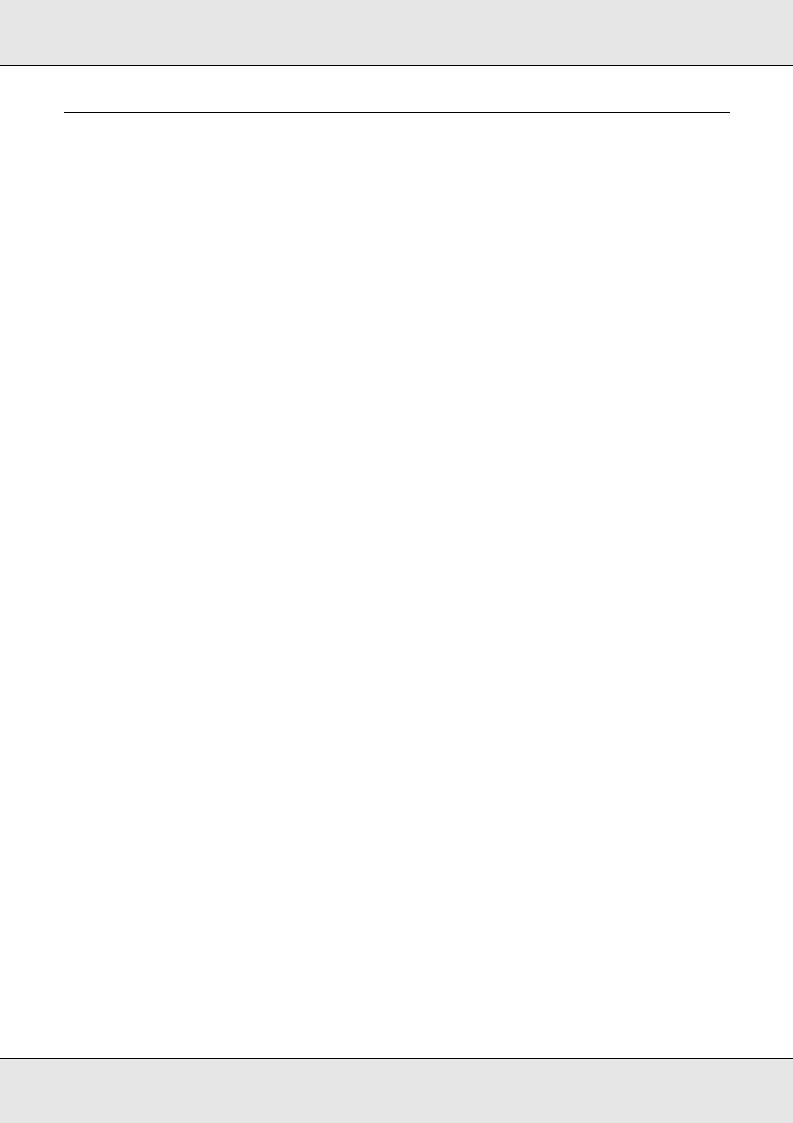
Network Guide
Installing Components on Your Computer
About Installing Components on Your Computer
Before configuring the network interface and printing from the computer, you need to install the necessary components (such as TCP/IP, NetBEUI, etc.) and assign an IP address and subnet mask for your computer, depending on the printing method you want to use. See the section in this chapter appropriate for your operating system.
Windows XP
For Windows XP, use the following procedure to install the necessary components.
Note:
The Windows XP CD-ROM may be required during the installation.
When using TCP/IP or IPP for printing, you need to set the IP address, the subnet mask, and the default gateway of the computer.
1.Click Start, highlight Control Panel, and then click Network and Internet Connections. Select Network Connections.
2.Under LAN or High-Speed Internet, click the Local Area Connection icon.
3.Under Network Tasks, click Change settings of this connection.
How To 19
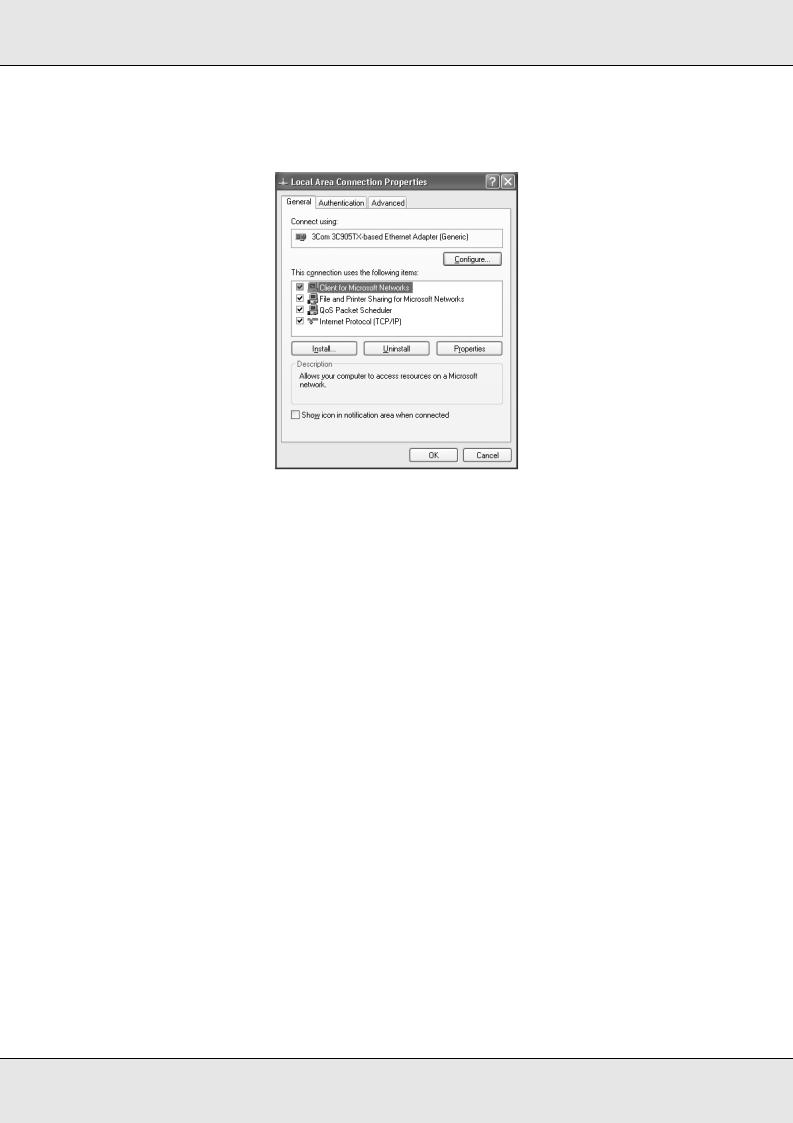
Network Guide
4.Check if the following necessary components are in the list. If they are already installed, go to the next chapter.
The following table lists the components required for configuring the network interface with EpsonNet Config.
EpsonNet Config’s setting screens |
Necessary components |
|
|
TCP/IP, AppleTalk, IPP, SNMP (IP trap) |
Internet Protocol (TCP/IP) |
|
|
MS Network |
Internet Protocol (TCP/IP) |
|
|
NetWare, SNMP (IPX trap)* |
Latest Novell Client downloaded from the Novell |
|
Web site |
|
|
* Only for printers supporting NetWare queue-based printing
The following table lists the components required for network printing.
Printing method |
Necessary components |
|
|
LPR or Internet printing |
Internet Protocol (TCP/IP) |
|
|
Microsoft Network Shared printing |
TCP/IP or NetBEUI |
|
Client for Microsoft Networks |
|
|
Printing via NetWare server* |
Latest Novell Client downloaded from the Novell |
|
Web site |
|
|
*If you are using a printer that does not support NetWare queue-based printing, print via the NetWare server using EpsonNet NDPS Gateway.
How To 20
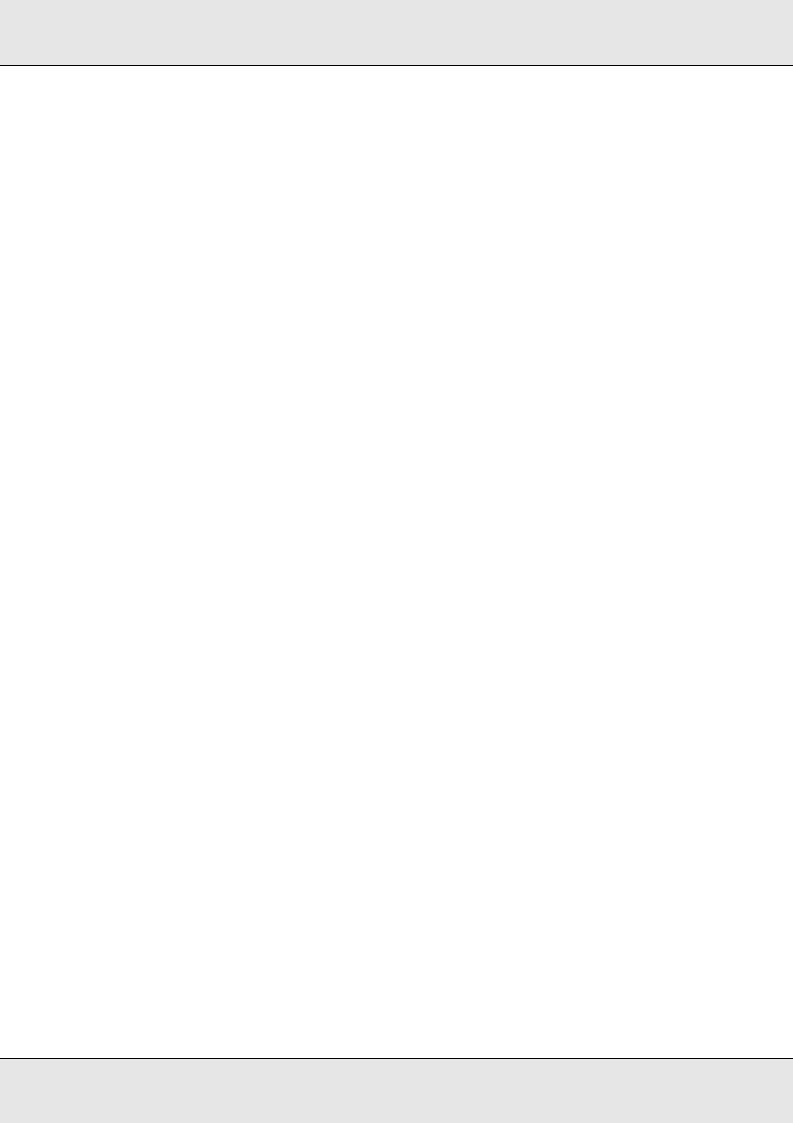
Network Guide
5.If the necessary components are not in the list, click Install to install them, as described below.
For LPR or Internet printing:
Internet Protocol (TCP/IP) is installed by default. You cannot add or delete it.
For Microsoft Network Shared printing:
Select Client and then click Add. Select Client for Microsoft Networks and then click
OK.
For printing via NetWare server:
Download the latest Novell Client from the Novell Web site and install it on the computer. Also, be sure to install either IP or IPX. See the Novell Web site for detailed information.
6.For LPR, Internet, Microsoft Network Shared printing:
Double-click Internet Protocol (TCP/IP) on the Local Area Connection Properties dialog box to open the Internet Protocols (TCP/IP) Properties dialog box. Set the IP address, the subnet mask, etc. and then click OK.
7.Restart the computer.
The necessary components are now installed. Go to the section “Connecting the Network
Interface to the Network” on page 31.
Windows Me/98
For Windows Me/98, use the following procedure to install the necessary components.
Note:
The Windows Me/98 CD-ROM may be required during the installation.
When using TCP/IP or IPP for printing, you need to set the IP address, the subnet mask, and the default gateway of the computer.
1. Click Start, point to Settings, and then select Control Panel.
How To 21
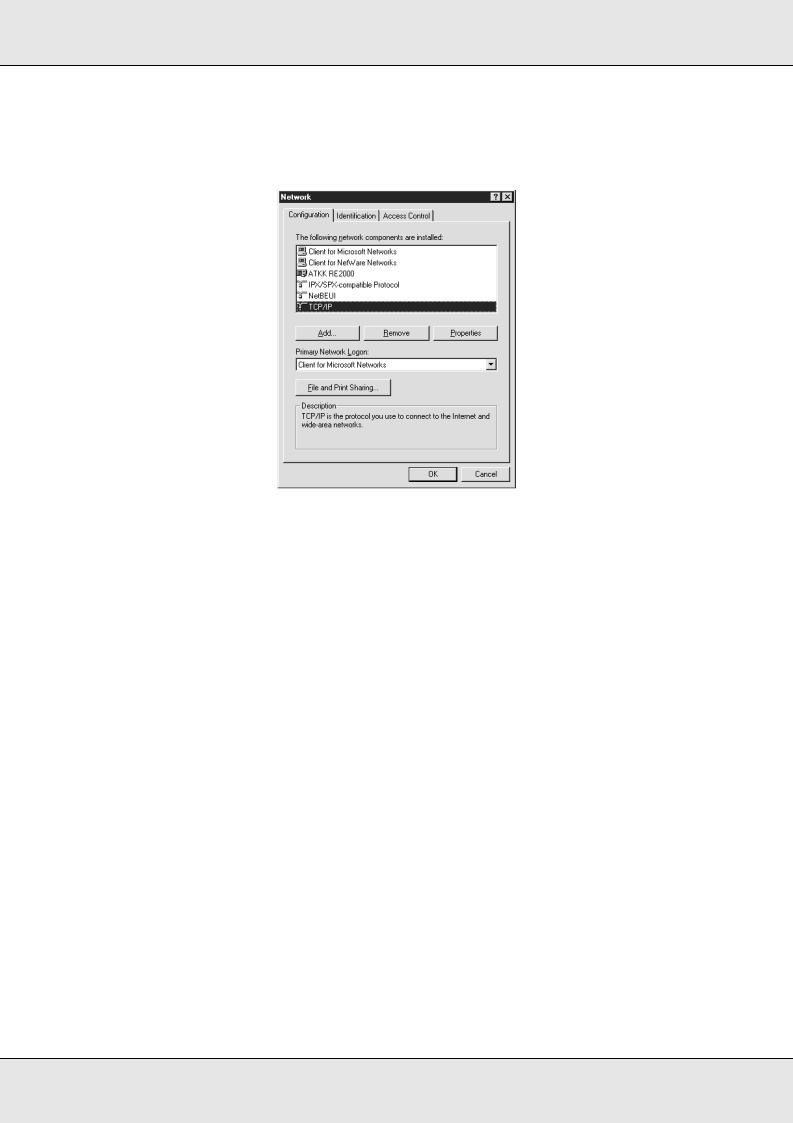
Network Guide
2.Double-click the Network icon. Check if the following necessary components are in the list of installed network components on the Configuration menu. If they are already installed, go to the next chapter.
The following table lists the components required for configuring the network interface with EpsonNet Config.
EpsonNet Config’s setting screens |
Necessary components |
|
|
TCP/IP, AppleTalk, IPP, SNMP (IP trap) |
TCP/IP |
|
|
MS Network |
NetBEUI or TCP/IP |
|
|
NetWare, SNMP (IPX trap)* |
Latest Novell Client downloaded from the Novell |
|
Web site |
|
|
* Only for printers supporting NetWare queue-based printing
Note for users of printers supporting NetWare queue-based printing:
Do not run Novell Client for Windows 95/98 version 3.00 and Novell Client for Windows NT version 4.50 when using the following modes: NetWare 3.x/4.x Bindery Print Server mode, NetWare 3.x Remote Printer mode, NetWare 4.x Bindery Remote Printer mode, and NetWare 4.x/5.x NDS Remote Printer mode.
The following table lists the components required for network printing.
How To 22
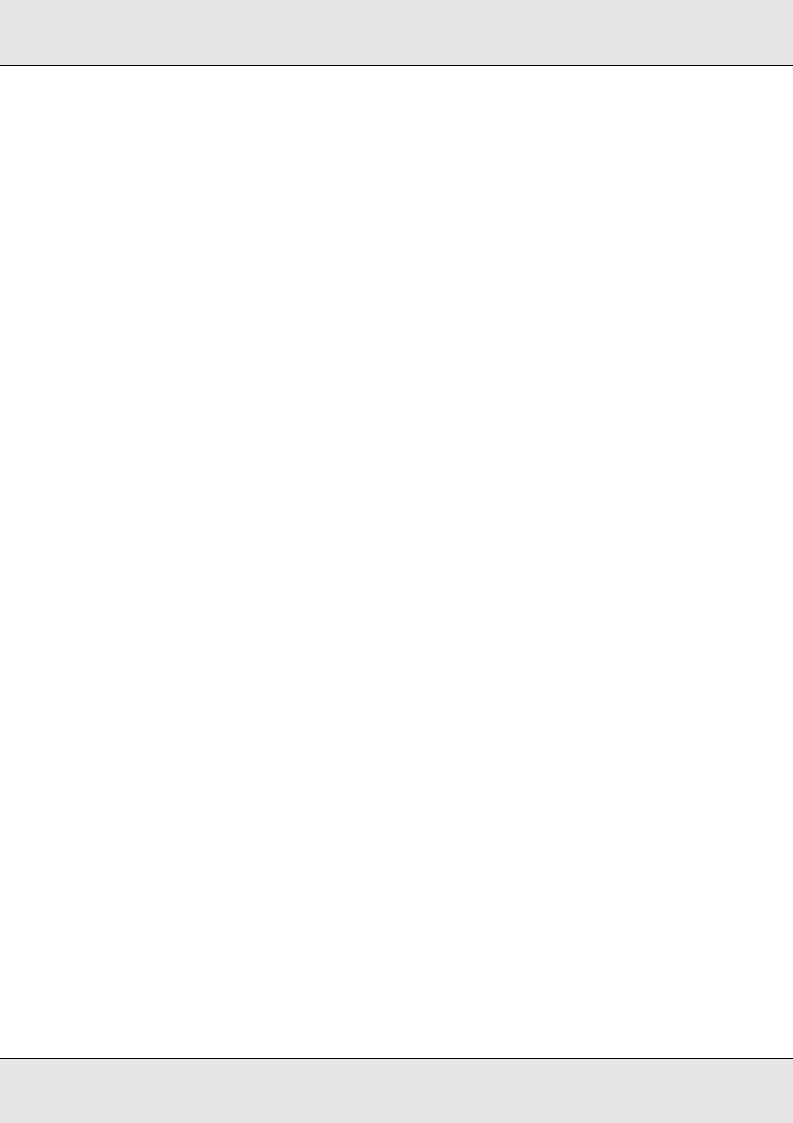
Network Guide
Printing method |
Necessary components |
|
|
LPR or Internet printing |
TCP/IP |
|
|
Microsoft Network Shared printing |
TCP/IP or NetBEUI |
|
Client for Microsoft Networks |
|
|
Printing via NetWare server* |
Latest Novell Client downloaded from the Novell |
|
Web site |
|
|
*If you are using a printer that does not support NetWare queue-based printing, print via the NetWare server using EpsonNet NDPS Gateway.
3.If the necessary components are not in the list, click Add to install them, as described below.
For LPR or Internet printing:
Select Protocol and then click Add. Select Microsoft from the Manufacturers list and
TCP/IP from the Network Protocols list. Then click OK.
For Microsoft Network Shared printing:
To use TCP/IP, see the description described earlier to install TCP/IP.
To use NetBEUI, select Protocol and then click Add. Select Microsoft from the
Manufacturers list and NetBEUI from the Network Protocols list. Then click OK. Select Client and then click Add. Select Microsoft from the Manufacturers list and
Client for Microsoft Networks from the Network Clients list. Then click OK.
For printing via NetWare server:
Download the latest Novell Client from the Novell Web site and install it on the computer. Also, be sure to install either IP or IPX. See the Novell Web site for detailed information.
4.For LPR, Internet, Microsoft Network Shared printing:
Double-click TCP/IP on the Configuration menu to open the TCP/IP Properties dialog box. Set the IP address, the subnet mask, etc. and then click OK.
5.Restart the computer.
The necessary components are now installed. Go to the section “Connecting the Network Interface to the Network” on page 31.
How To 23

Network Guide
Windows Server 2003
For Windows Server 2003, use the following procedure to install the necessary components.
Note:
The Windows Server 2003 CD-ROM may be required during the installation.
When using TCP/IP or IPP for printing, you need to set the IP address, the subnet mask, and the default gateway of the computer.
1.Click Start, point to Control Panel, and then select Network Connections. Click Local Area Connections.
2.Click the Properties button.
3.Check if the following necessary components are in the list. If they are already installed, go to the next chapter.
The following table lists the components required for configuring the network interface with EpsonNet Config.
EpsonNet Config’s setting screens |
Necessary components |
|
|
TCP/IP, AppleTalk, IPP, SNMP (IP trap) |
Internet Protocol (TCP/IP) |
|
|
MS Network |
Internet Protocol (TCP/IP) |
|
|
NetWare, SNMP (IPX trap)* |
Latest Novell Client downloaded from the Novell |
|
Web site |
|
|
* Only for printers supporting NetWare queue-based printing
How To 24
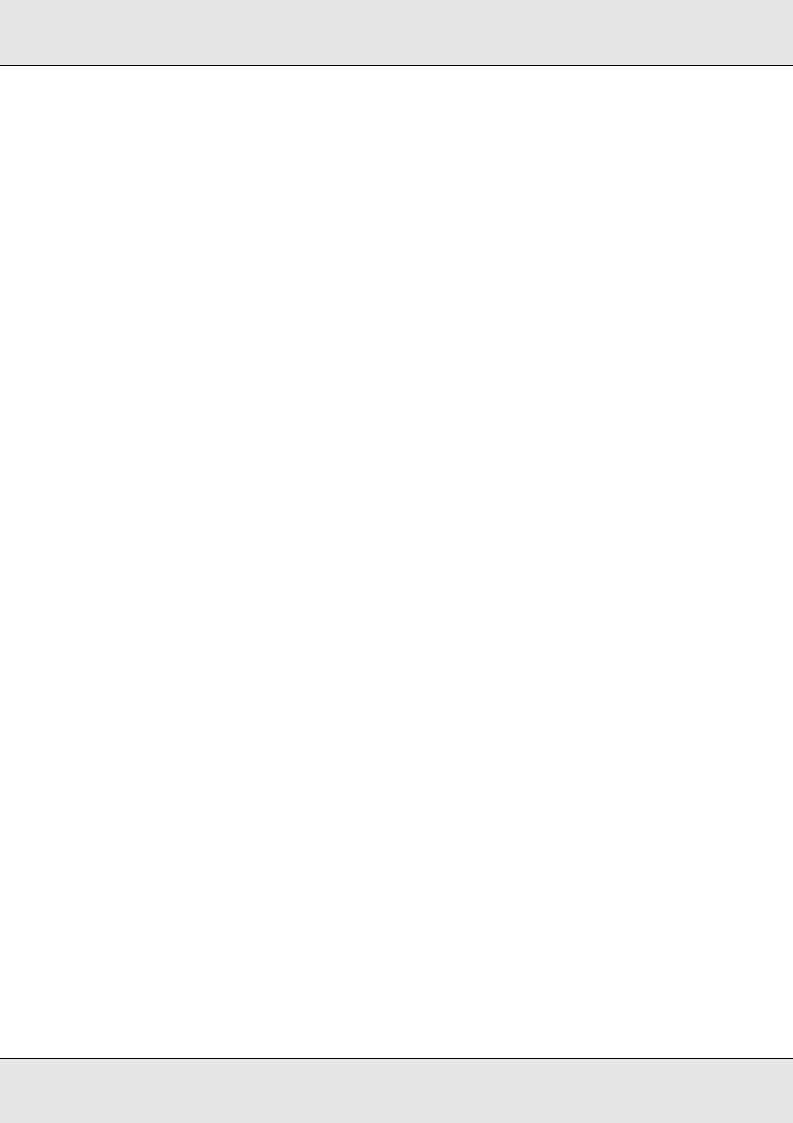
Network Guide
The following table lists the components required for network printing.
Printing method |
Necessary components |
|
|
LPR or Internet printing |
Internet Protocol (TCP/IP) |
|
|
Microsoft Network Shared printing |
TCP/IP or NetBEUI |
|
Client for Microsoft Networks |
|
|
Printing via NetWare server* |
Latest Novell Client downloaded from the Novell |
|
Web site |
|
|
*If you are using a printer that does not support NetWare queue-based printing, print via the NetWare server using EpsonNet NDPS Gateway.
4.If the necessary components are not in the list, click Install to install them, as described below.
For LPR or Internet printing:
Internet Protocol (TCP/IP) is installed by default. You cannot add or delete it.
For Microsoft Network Shared printing:
Select Client and then click Add. Select Client for Microsoft Networks and then click
OK.
For printing via NetWare server:
Download the latest Novell Client from the Novell Web site and install it on the computer. Also, be sure to install either IP or IPX. See the Novell Web site for detailed information.
5.For LPR, Internet, Microsoft Network Shared printing:
Double-click Internet Protocol (TCP/IP) on the Local Area Connection Properties dialog box to open the Internet Protocols (TCP/IP) Properties dialog box. Set the IP address, the subnet mask, etc. and then click OK.
6.Restart the computer.
The necessary components are now installed. Go to the section “Connecting the Network
Interface to the Network” on page 31.
How To 25
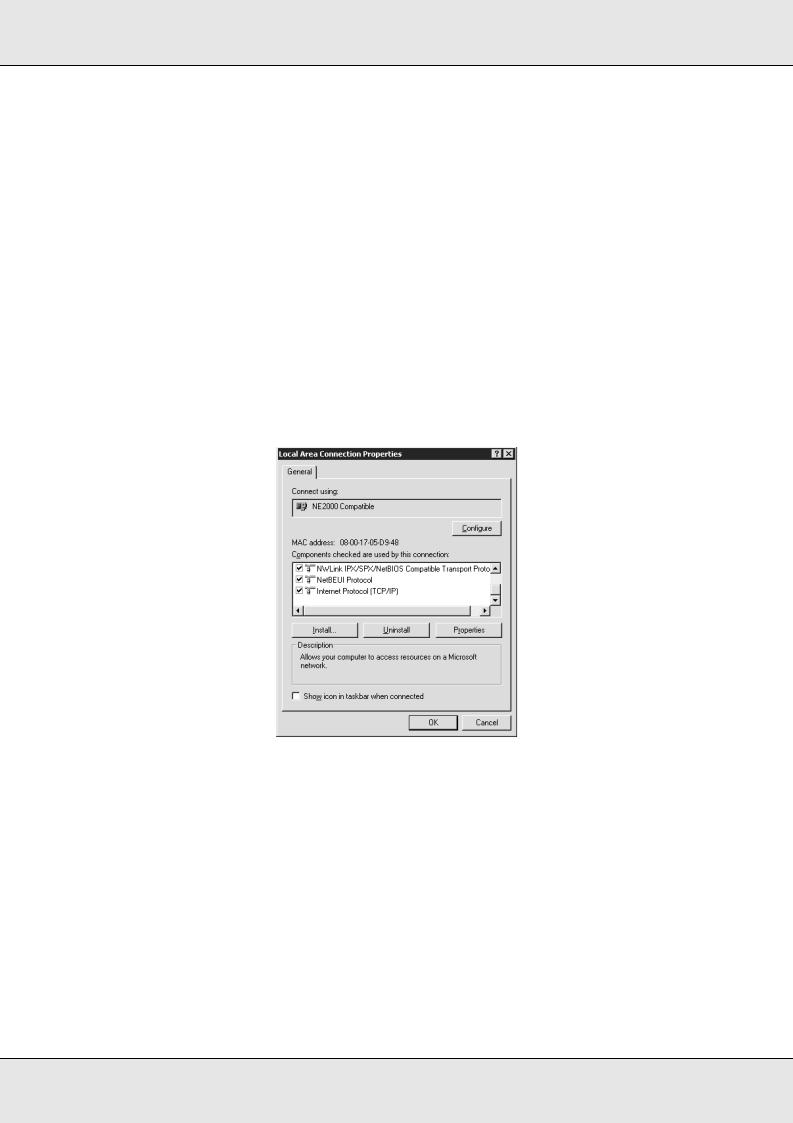
Network Guide
Windows 2000
For Windows 2000, use the following procedure to install the necessary components.
Note:
The Windows 2000 CD-ROM may be required during the installation.
When using TCP/IP or IPP for printing, you need to set the IP address, the subnet mask, and the default gateway of the computer.
1.Click Start, point to Settings, and then select Network and Dial-up Connections. The
Network and Dial-up Connections screen appears.
2.Right-click the desired network connection and then select Properties.
3.Check if the following necessary components are in the list. If they are already installed, go to the next chapter.
The following table lists the components required for configuring the network interface with EpsonNet Config.
EpsonNet Config’s setting screens |
Necessary components |
|
|
TCP/IP, AppleTalk, IPP, SNMP (IP trap) |
Internet Protocol (TCP/IP) |
|
|
MS Network |
NetBEUI or Internet Protocol (TCP/IP) |
|
|
NetWare, SNMP (IPX trap)* |
Latest Novell Client downloaded from the Novell |
|
Web site |
|
|
* Only for printers supporting NetWare queue-based printing
How To 26
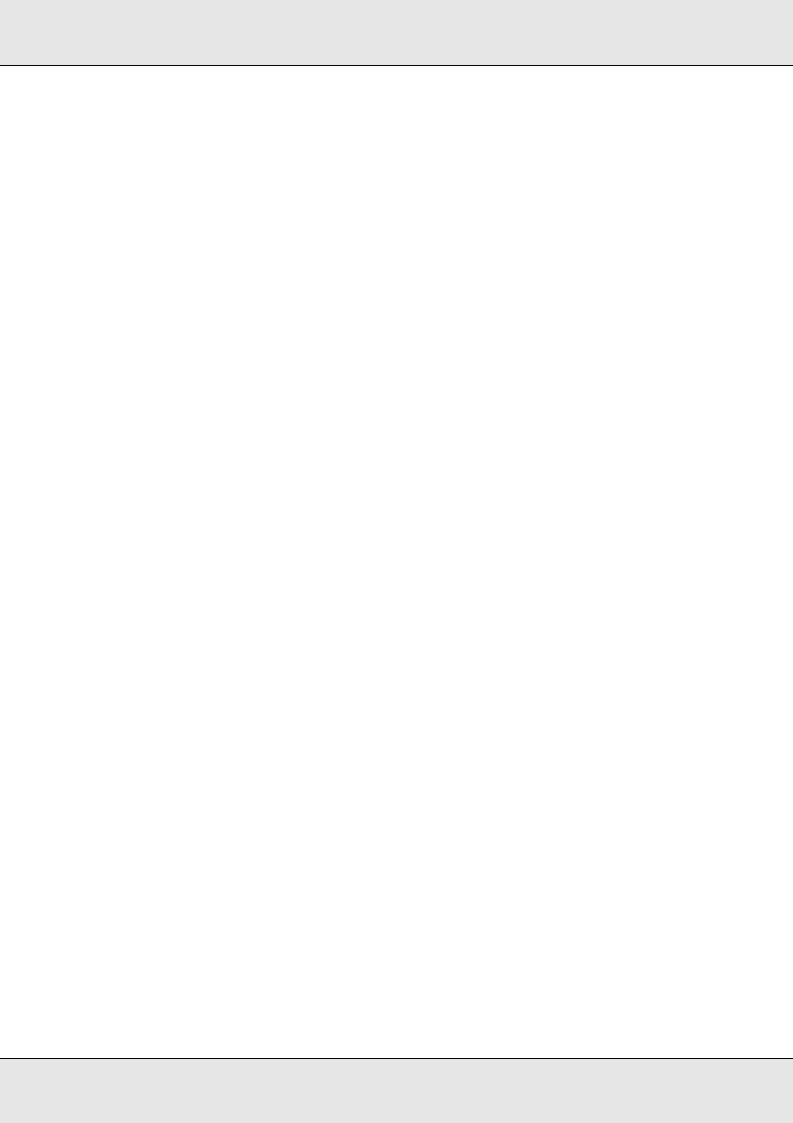
Network Guide
Note for users of printers supporting NetWare queue-based printing:
Do not run Novell Client for Windows 95/98 version 3.00 and Novell Client for Windows NT version 4.50 when using the following modes: NetWare 3.x/4.x Bindery Print Server mode, NetWare 3.x Remote Printer mode, NetWare 4.x Bindery Remote Printer mode, and NetWare 4.x/5.x NDS Remote Printer mode.
The following table lists the components required for network printing.
Printing method |
Necessary components |
|
|
LPR or Internet printing |
Internet Protocol (TCP/IP) |
|
|
Microsoft Network Shared printing |
Internet Protocol (TCP/IP) or NetBEUI |
|
Client for Microsoft Networks |
|
|
Printing via NetWare server* |
Latest Novell Client downloaded from the Novell |
|
Web site |
|
|
*If you are using a printer that does not support NetWare queue-based printing, print via the NetWare server using EpsonNet NDPS Gateway.
4.If the necessary components are not in the list, click Install to install them, as described below.
For LPR or Internet printing:
Select Protocol and then click Add. In the Select Network Protocol dialog box, select
Internet Protocol (TCP/IP) and then click OK.
For Microsoft Network Shared printing:
To use Internet Protocol, see the description described earlier to install Internet Protocol (TCP/IP).
To use NetBEUI, select Protocol and then click Add. Select NetBEUI Protocol and then click OK.
Select Client and then click Add. Select Client for Microsoft Networks and then click
OK.
For printing via NetWare server:
Download the latest Novell Client from the Novell Web site and install it on the computer. Also, be sure to install either IP or IPX. See the Novell Web site for detailed information.
5.For LPR, Internet, Microsoft Network Shared printing:
Double-click Internet Protocol (TCP/IP) on the Configuration menu to open the TCP/IP Properties dialog box. Set the IP address, the subnet mask, etc. and then click
OK.
6.Restart the computer.
The necessary components are now installed. Go to the section “Connecting the Network
Interface to the Network” on page 31.
How To 27

Network Guide
Windows NT 4.0
For Windows NT 4.0, use the following procedure to install the necessary components.
Note:
The Windows NT 4.0 CD-ROM may be required during the installation.
When using TCP/IP or IPP for printing, you need to set the IP address, the subnet mask, and the default gateway of the computer.
1.Click Start, point to Settings, and then select Control Panel.
2.Double-click the Network icon in the Control Panel.
3.Check if the following necessary components are in the list. If they are already installed, go to the next chapter.
The following table lists the components required for configuring the network interface with EpsonNet Config.
EpsonNet Config’s setting screens |
Necessary components |
|
|
TCP/IP, AppleTalk, IPP, SNMP (IP trap) |
TCP/IP |
|
|
MS Network |
NetBEUI or TCP/IP |
|
|
NetWare, SNMP (IPX trap)* |
Latest Novell Client downloaded from the Novell |
|
Web site |
|
|
* Only for printers supporting NetWare queue-based printing
How To 28
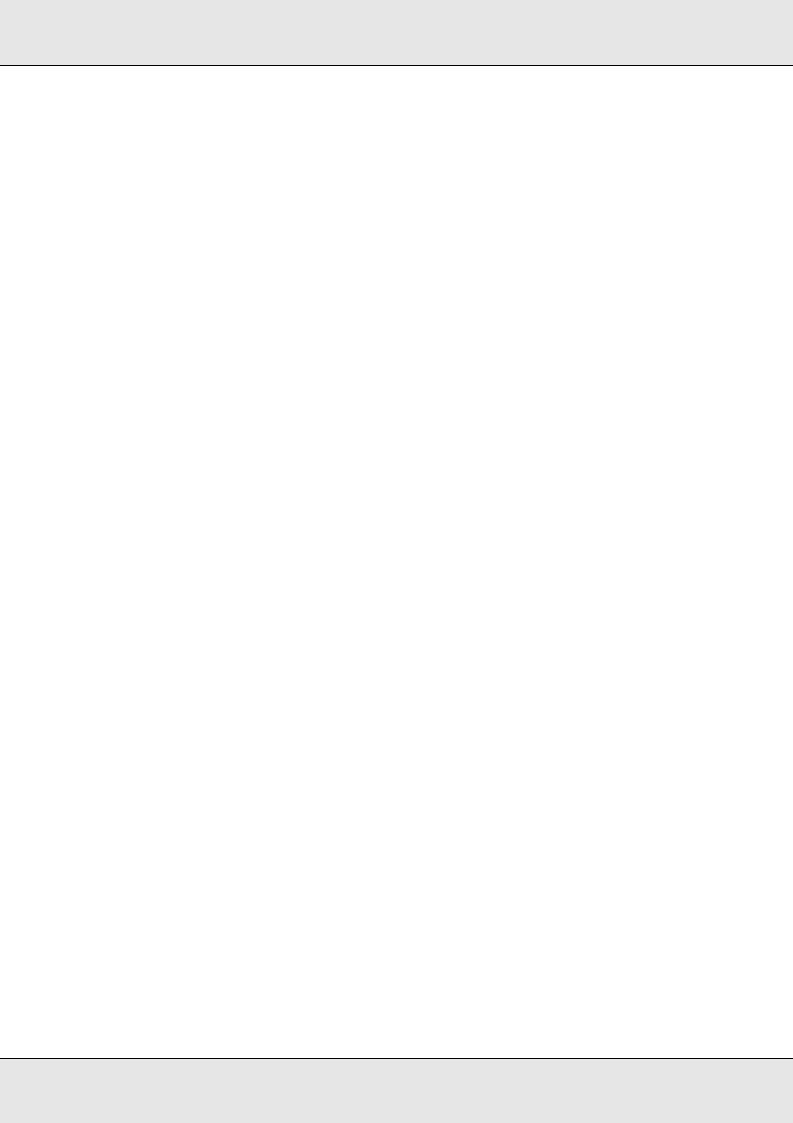
Network Guide
Note for users of printers supporting NetWare queue-based printing:
Do not run Novell Client for Windows 95/98 version 3.00 and Novell Client for Windows NT version 4.50 when using the following modes: NetWare 3.x/4.x Bindery Print Server mode, NetWare 3.x Remote Printer mode, NetWare 4.x Bindery Remote Printer mode, and NetWare 4.x/5.x NDS Remote Printer mode.
The following table lists the components required for network printing.
Printing method |
Necessary components |
|
|
LPR or Internet printing |
Protocols menu: TCP/IP |
|
Services menu: Microsoft TCP/IP Printing |
|
|
Microsoft Network Shared printing |
Protocols menu: TCP/IP or NetBEUI |
|
Services menu: Workstation |
|
|
Printing via NetWare server* |
Latest Novell Client downloaded from the Novell |
|
Web site |
|
|
*If you are using a printer that does not support NetWare queue-based printing, print via the NetWare server using EpsonNet NDPS Gateway.
4.If the necessary components are not in the list, click Add to install them, as described below.
For LPR or Internet printing:
Select the Protocols tab and then click Add. Select TCP/IP from the list and then click
OK. Set the IP address, the subnet mask, etc. and then click OK.
Select the Services tab and then click Add. Select Microsoft TCP/IP Printing from the list and then click OK.
For Microsoft Network Shared printing:
To use TCP/IP, see the description described earlier to install TCP/IP.
To use NetBEUI, select the Protocols tab and then click Add. Select NetBEUI from the list and then click OK.
Select the Services tab and then click Add. Select Workstation from the list and then click OK.
How To 29
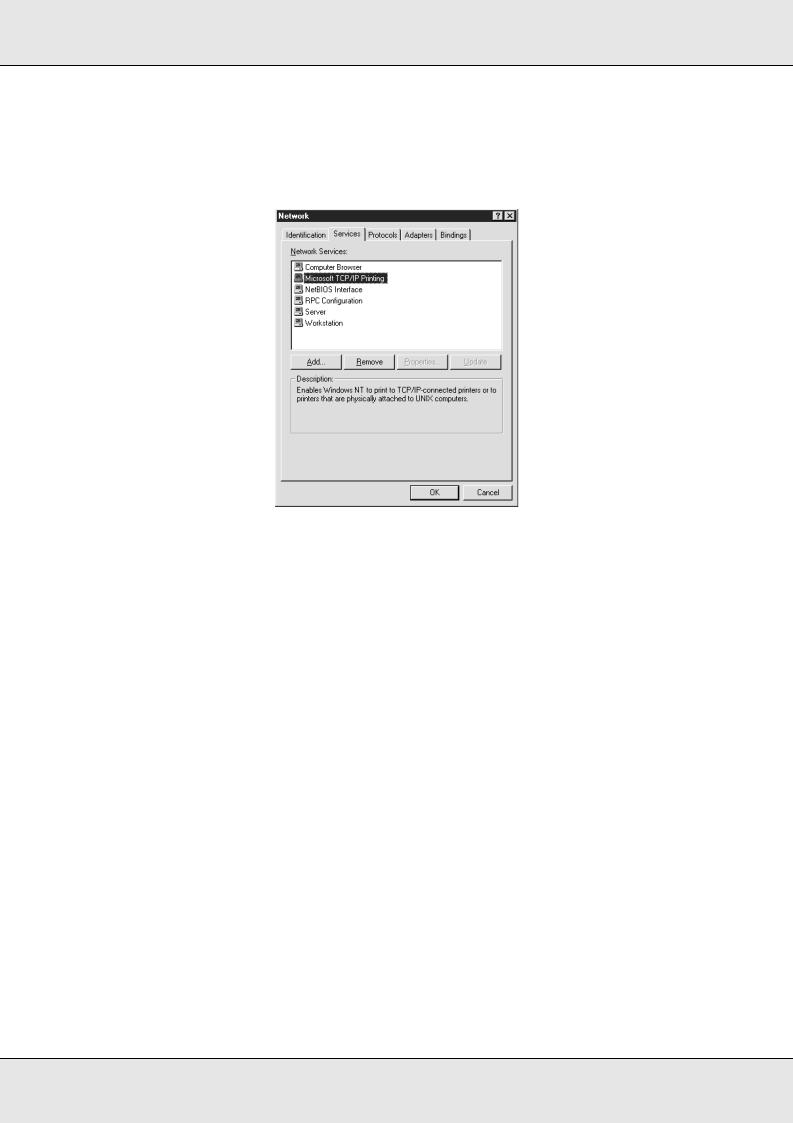
Network Guide
For printing via NetWare server:
Download the latest Novell Client from the Novell Web site and install it on the computer. Also, be sure to install either IP or IPX. See the Novell Web site for detailed information.
5. Restart the computer.
The necessary components are now installed. Go to the section “Connecting the Network Interface to the Network” on page 31.
Macintosh
To assign an IP address, subnet mask, etc. to your Macintosh, follow the steps below.
Note:
To print using the AppleTalk protocol and configure the network interface with EpsonNet Config for Macintosh, select Ethernet or Built-in Ethernet on the AppleTalk Control Panel or the AppleTalk tab. Then configure the network interface with EpsonNet Config for Macintosh.
Mac OS X
1.From the Apple menu, select System Preferences.
2.Open the Network control panel. Click the TCP/IP tab.
3.Select Built-in Ethernet from the Show pull down menu.
4.Assign an IP address and other settings if necessary.
How To 30
